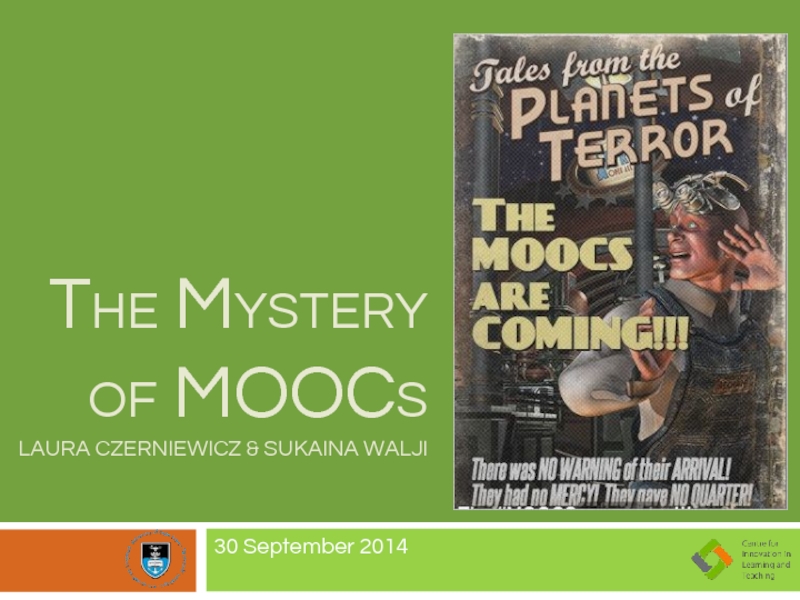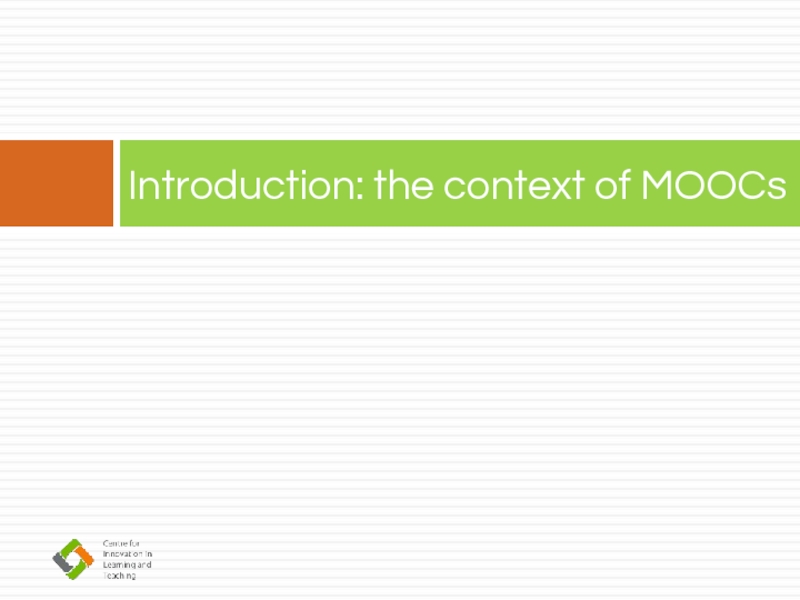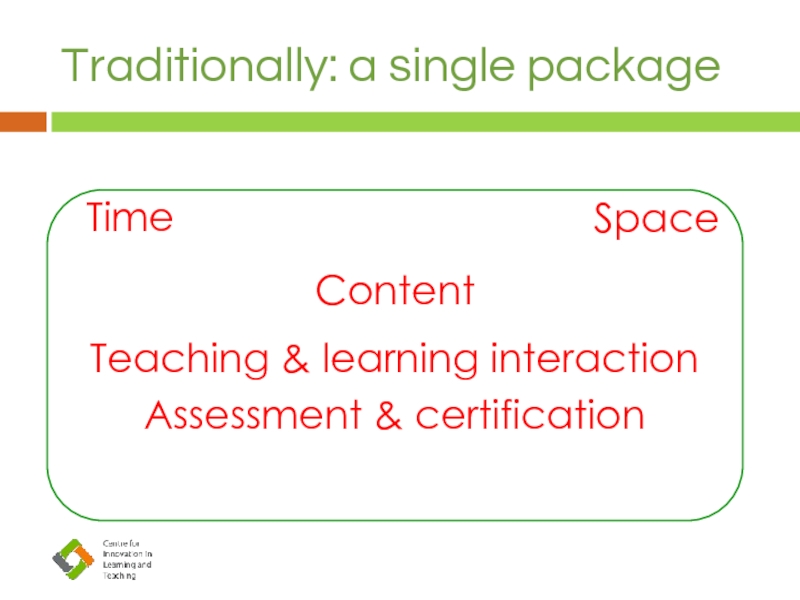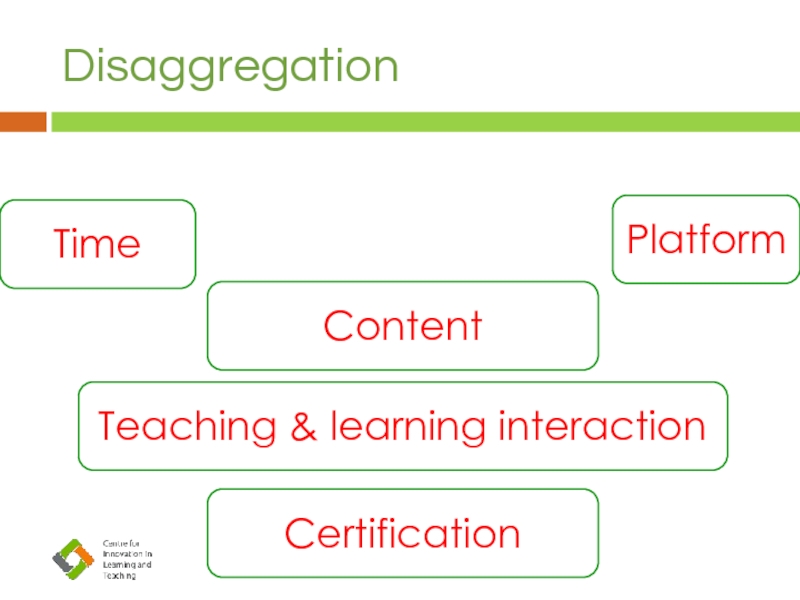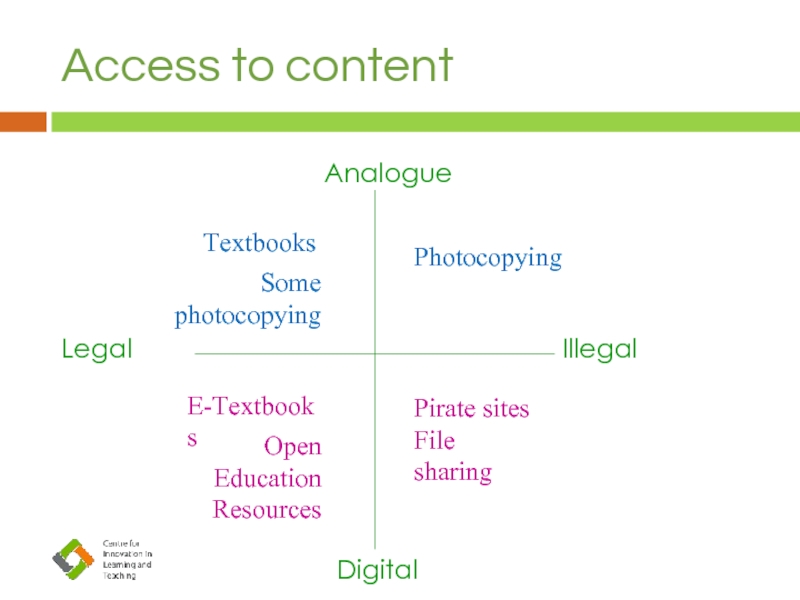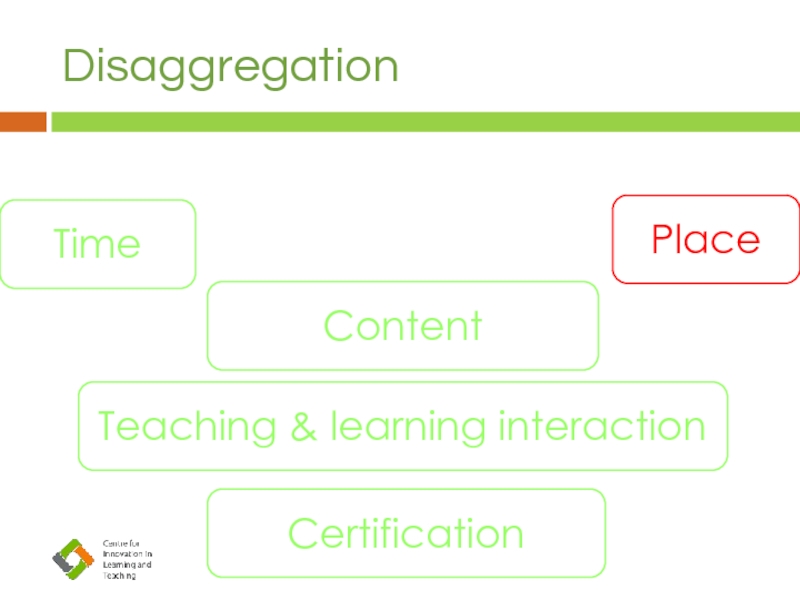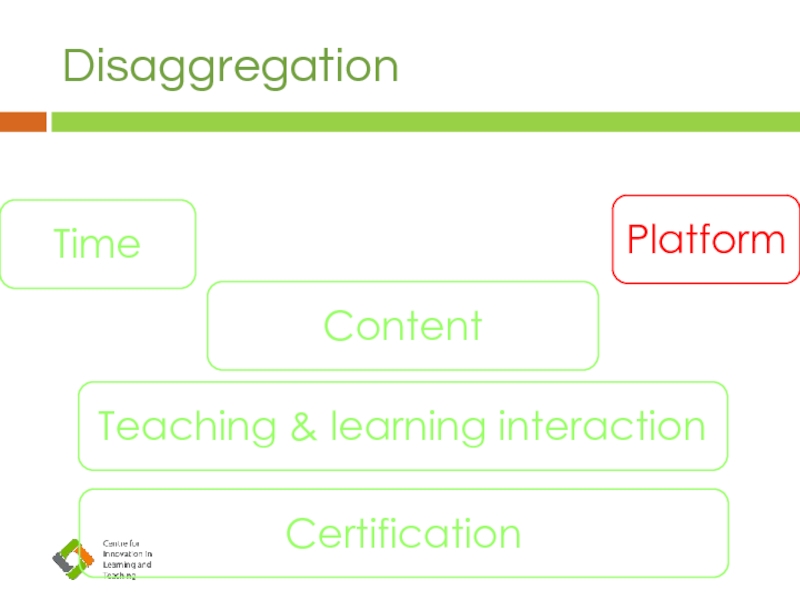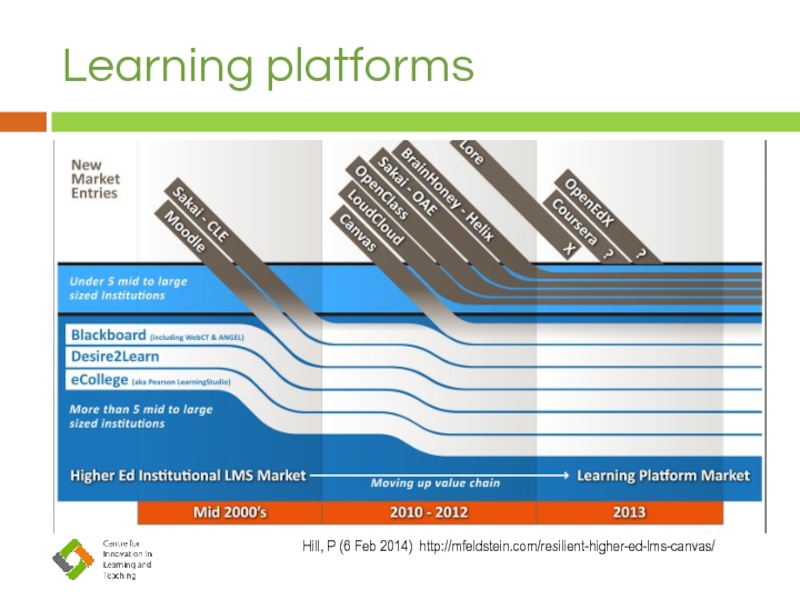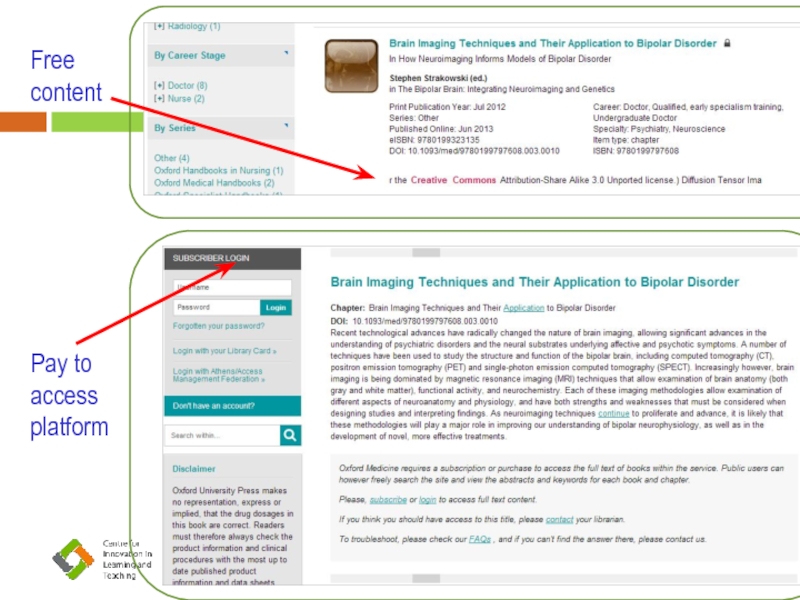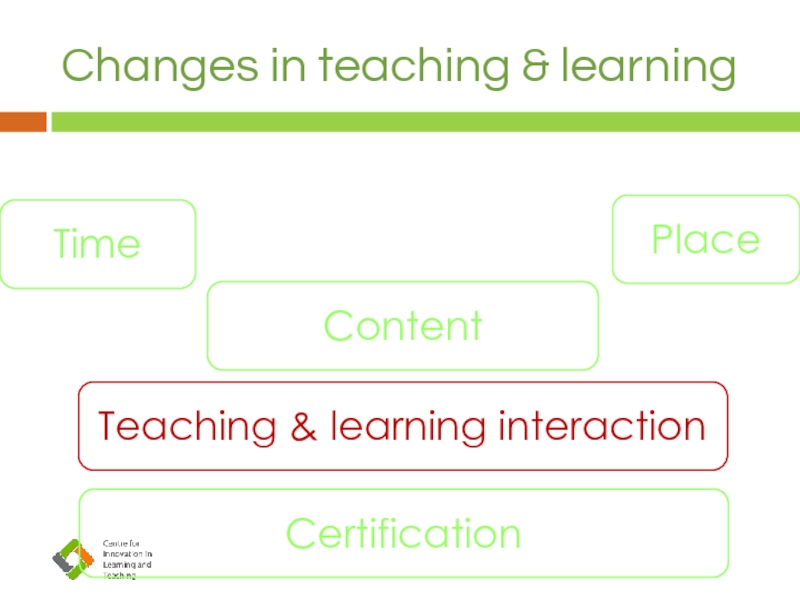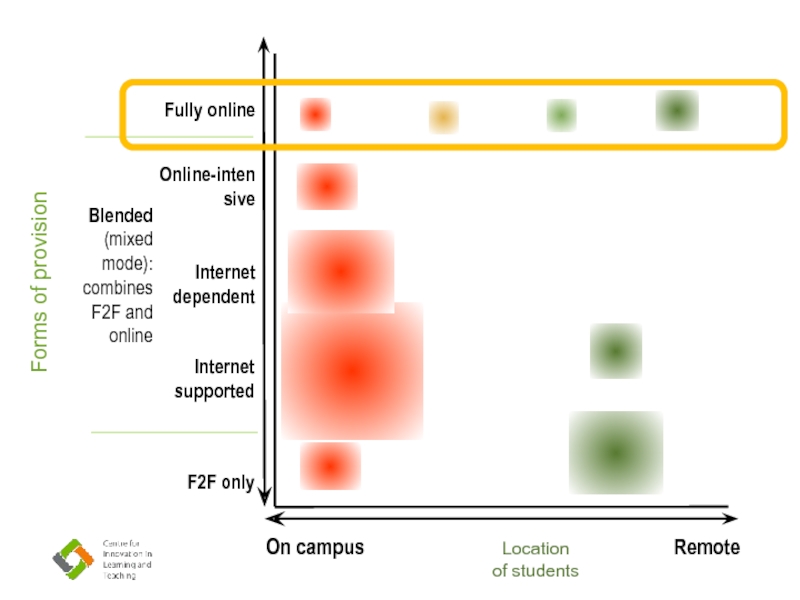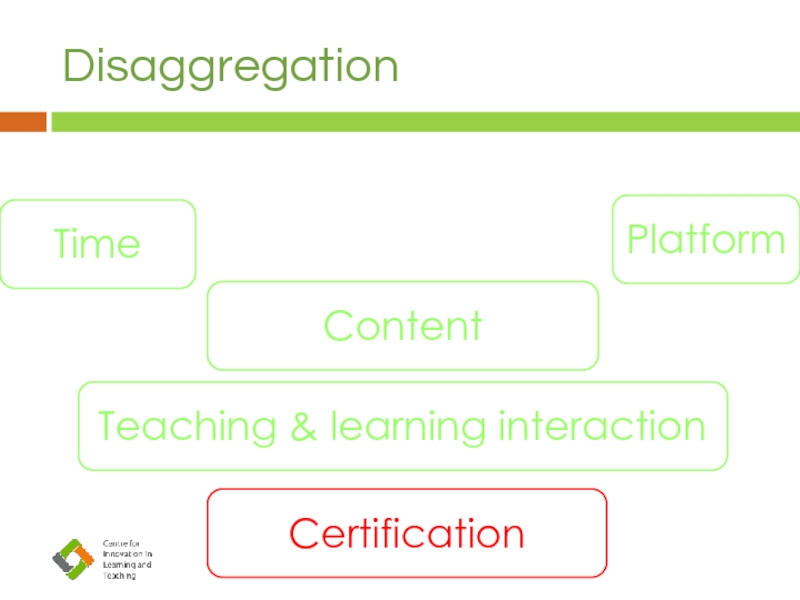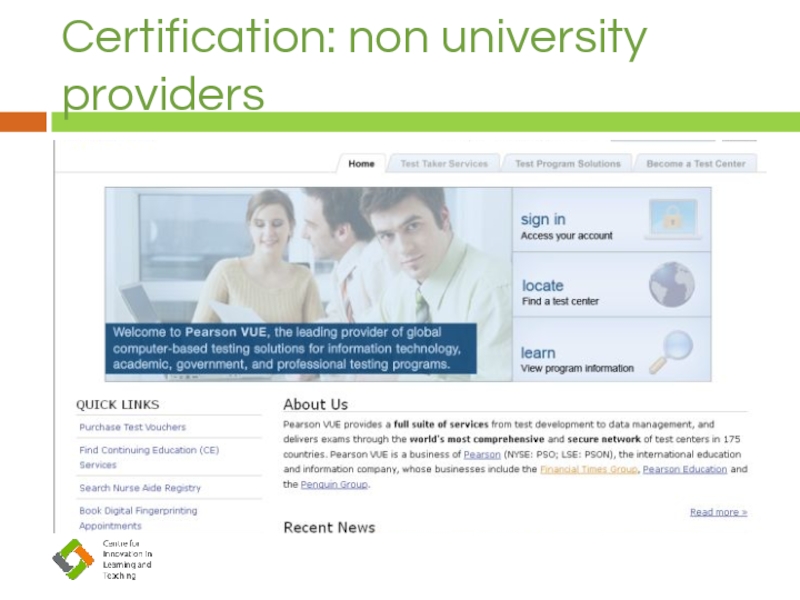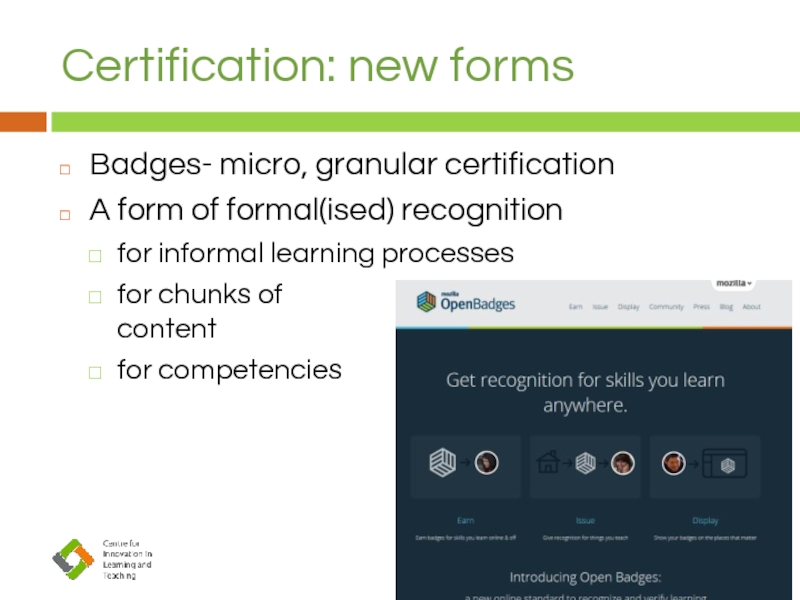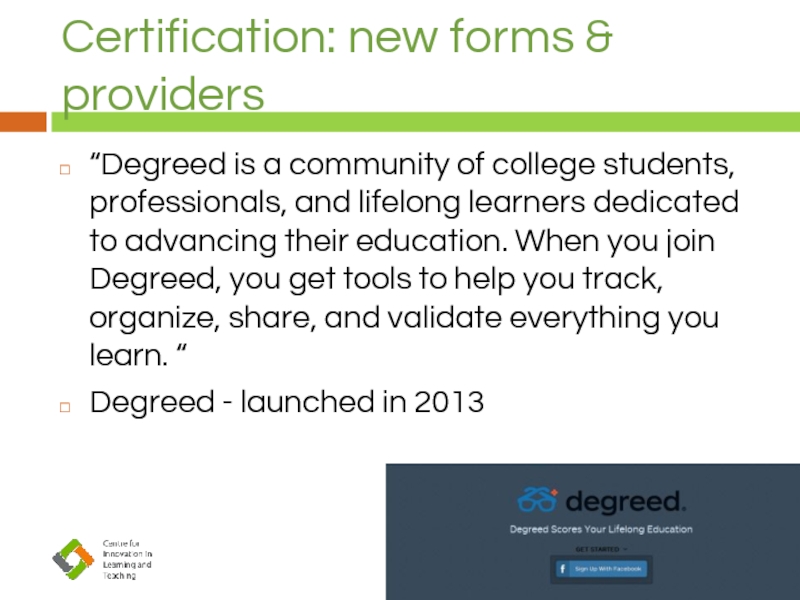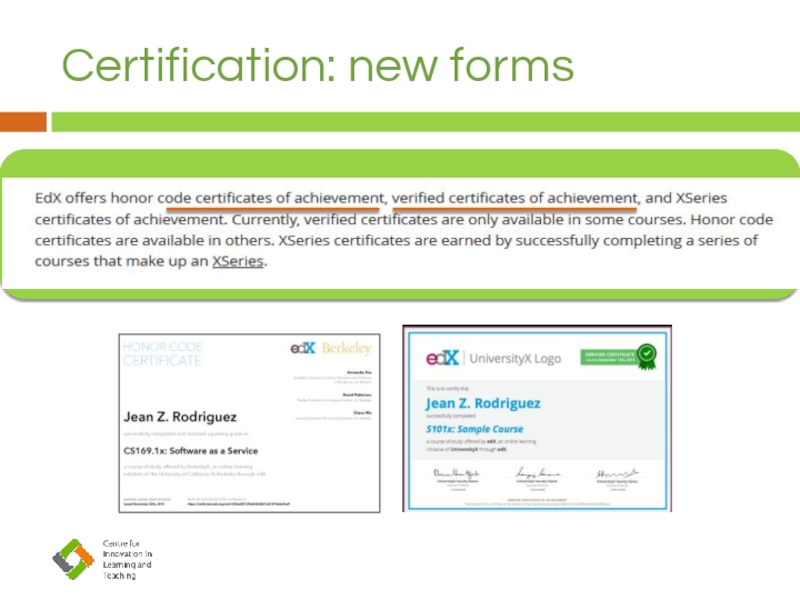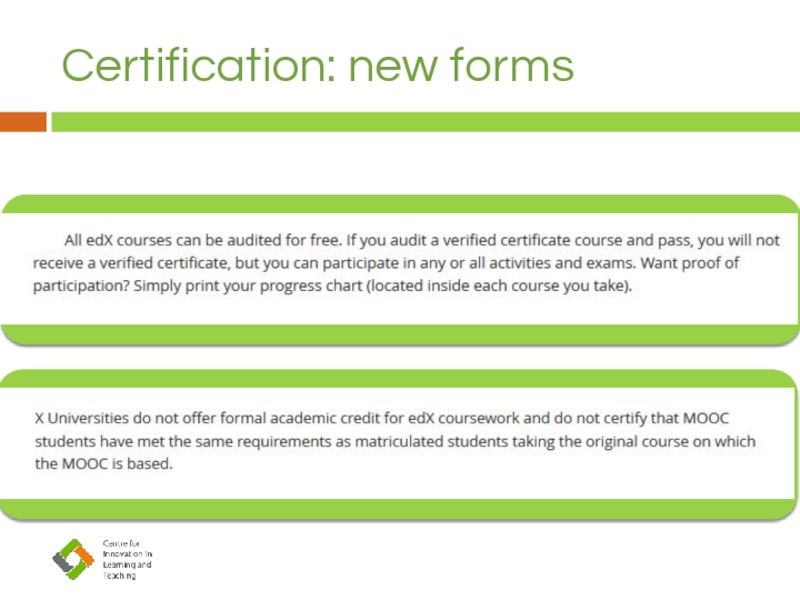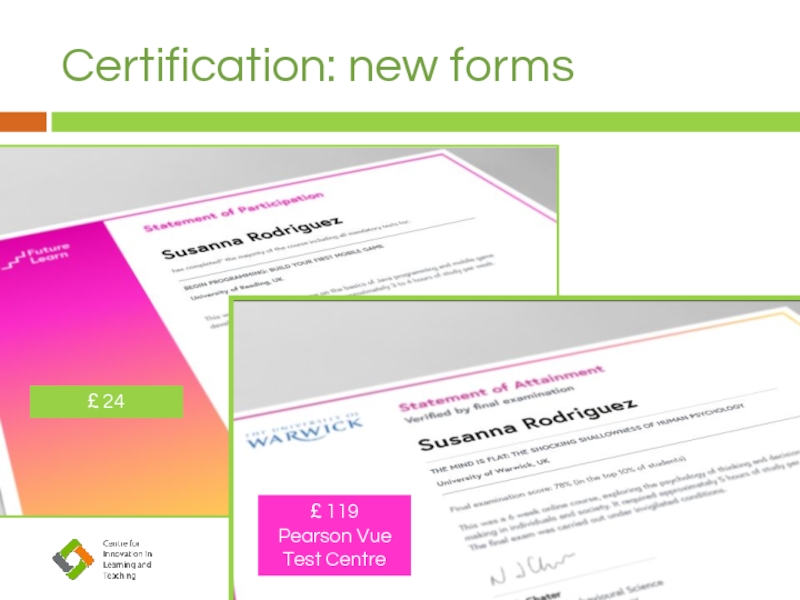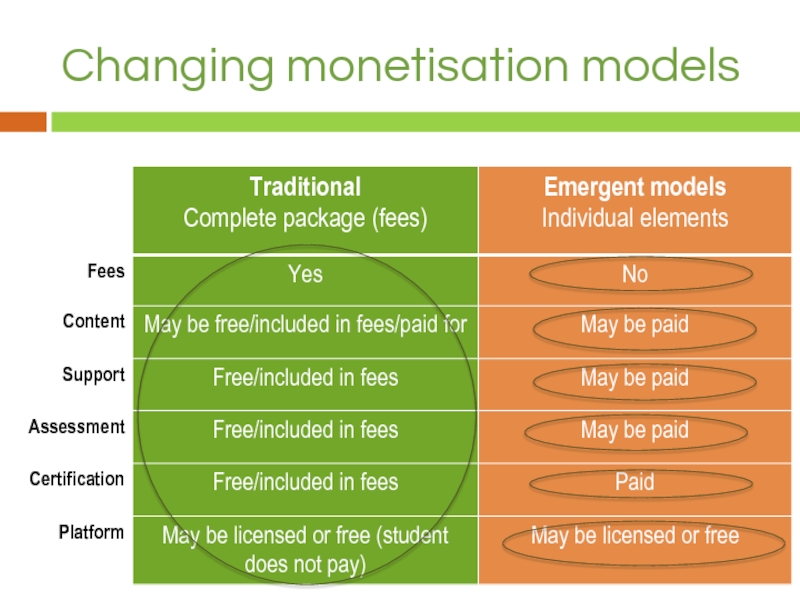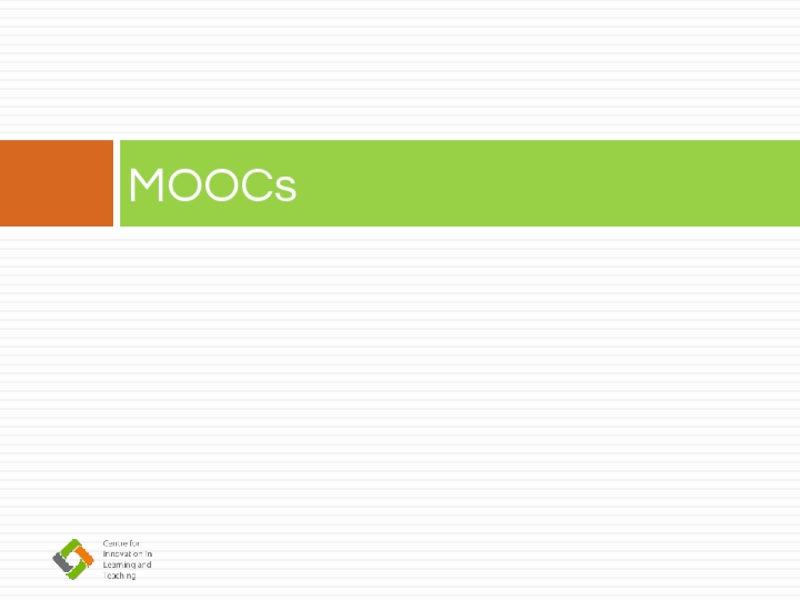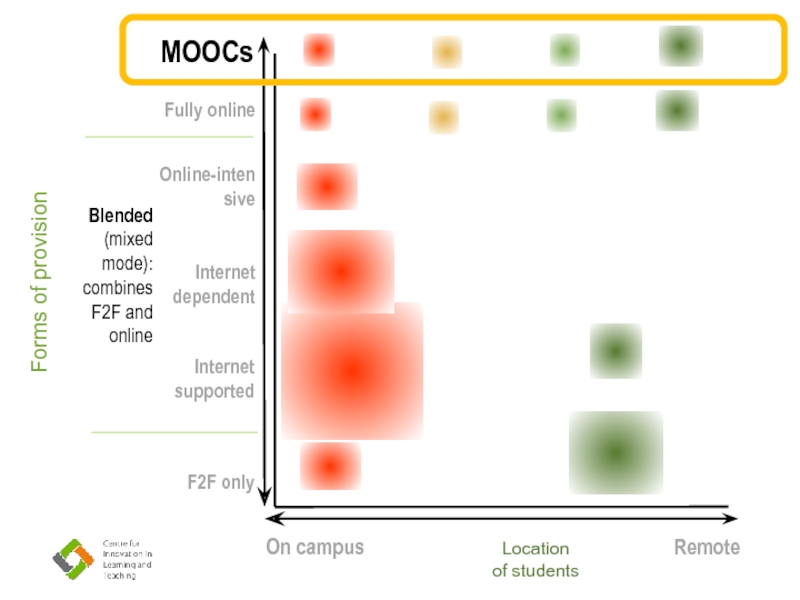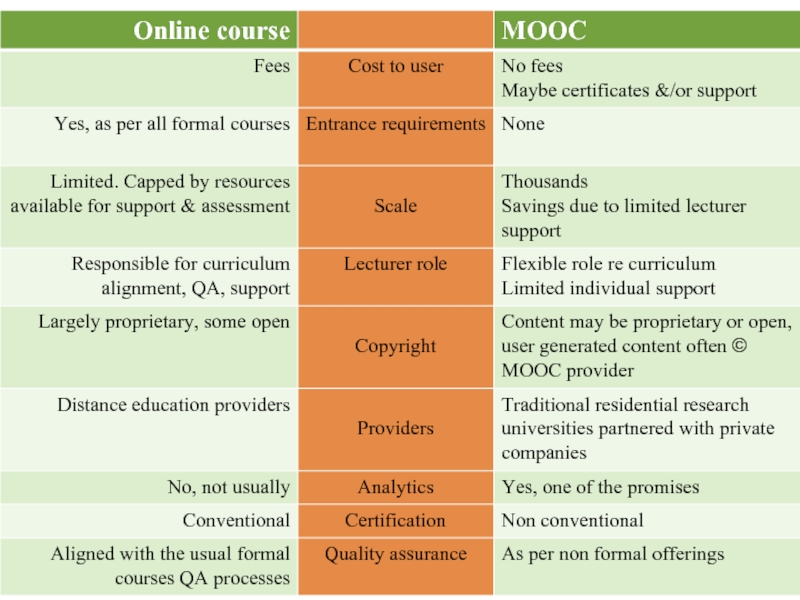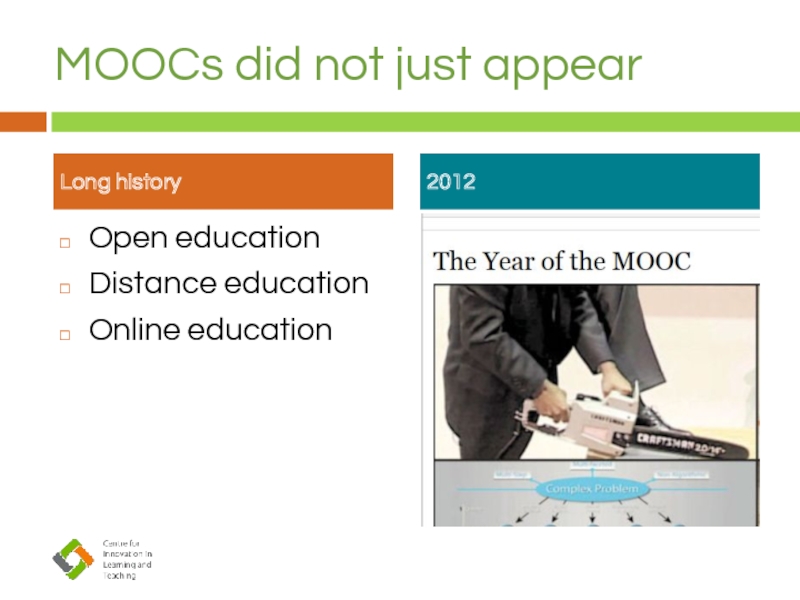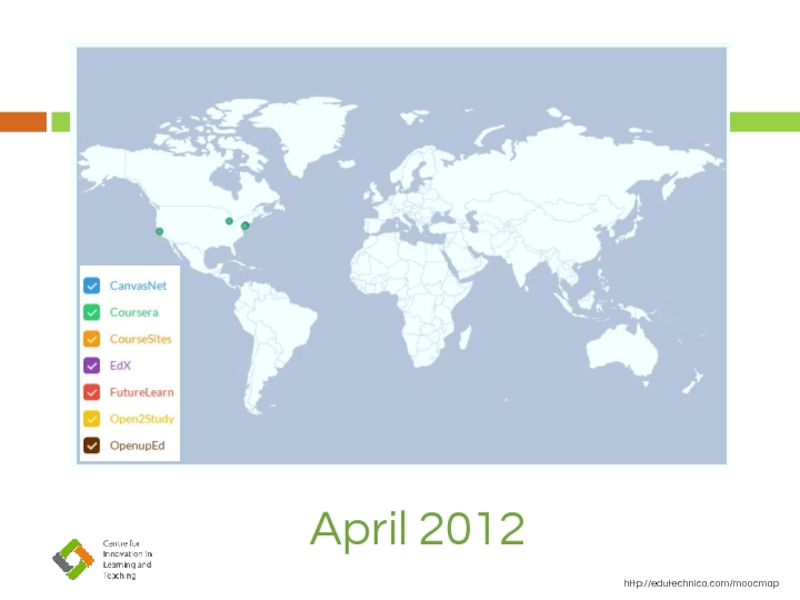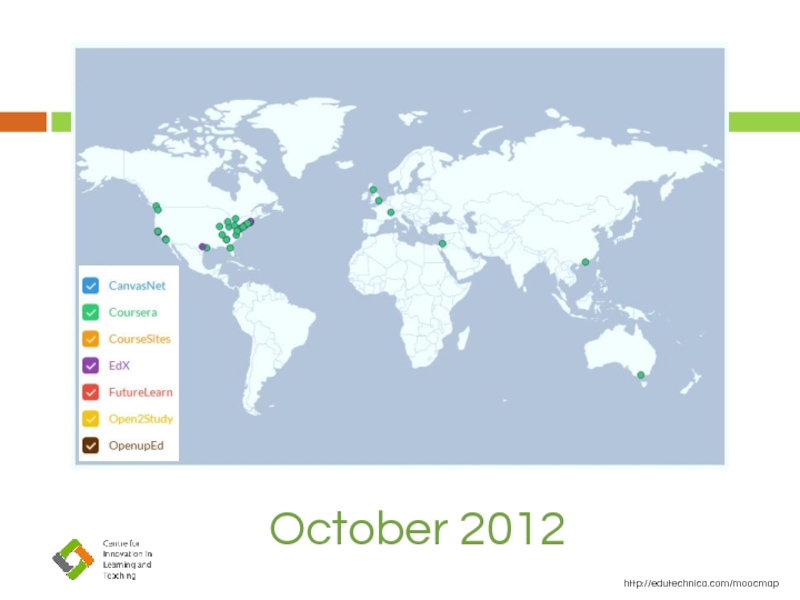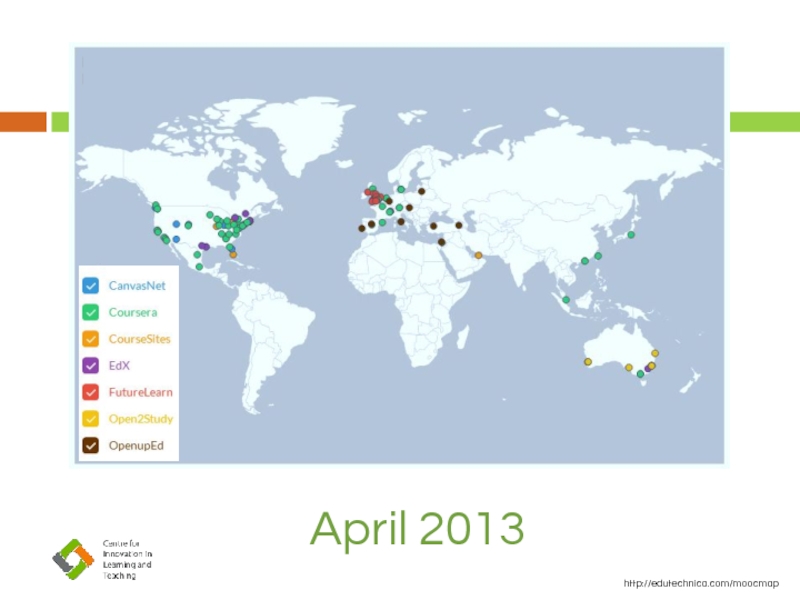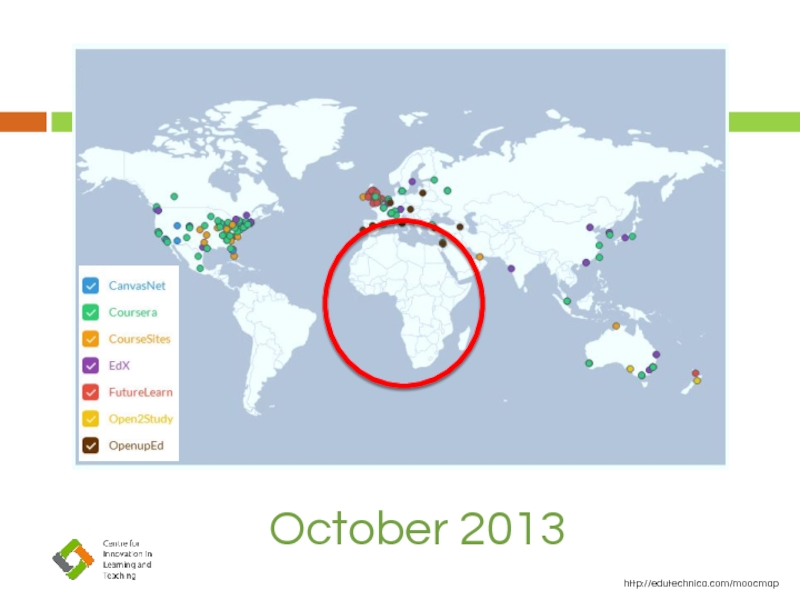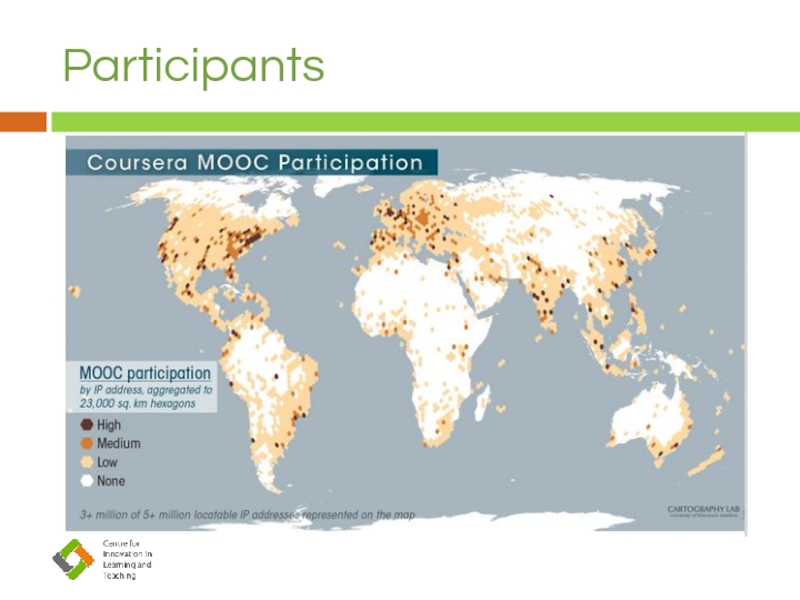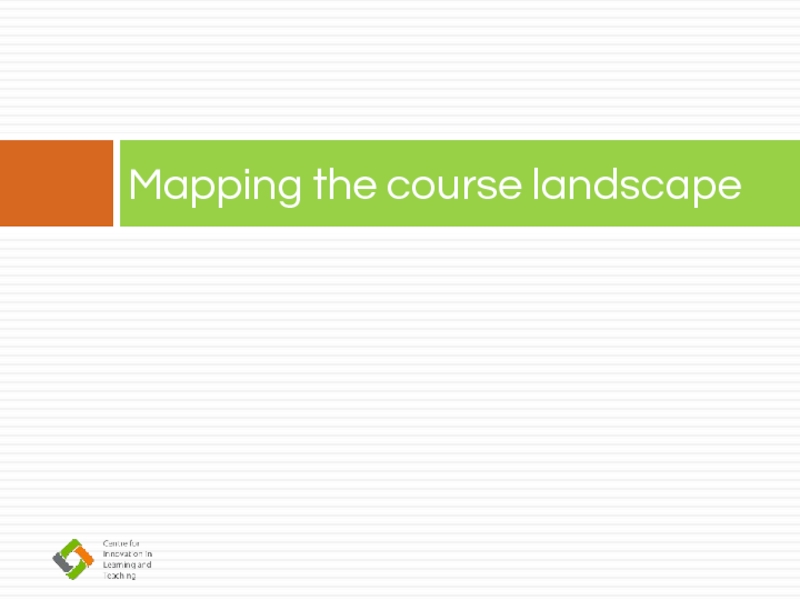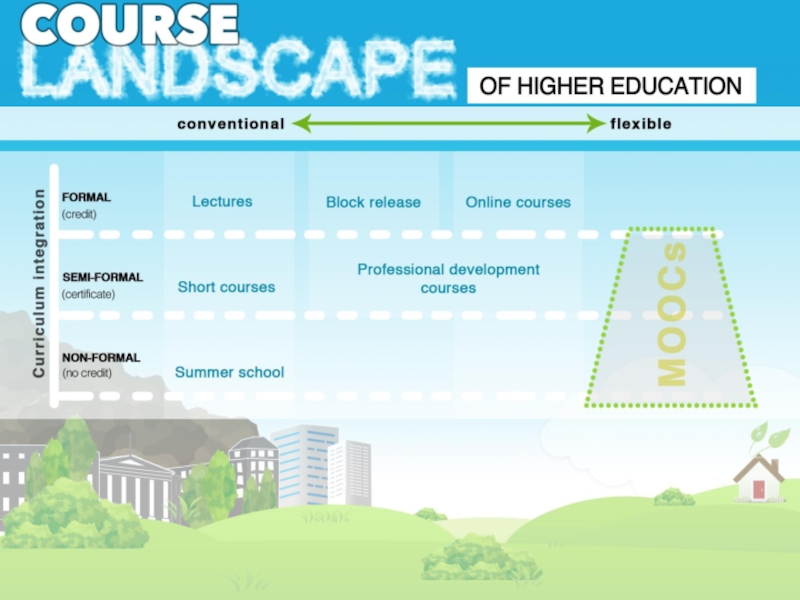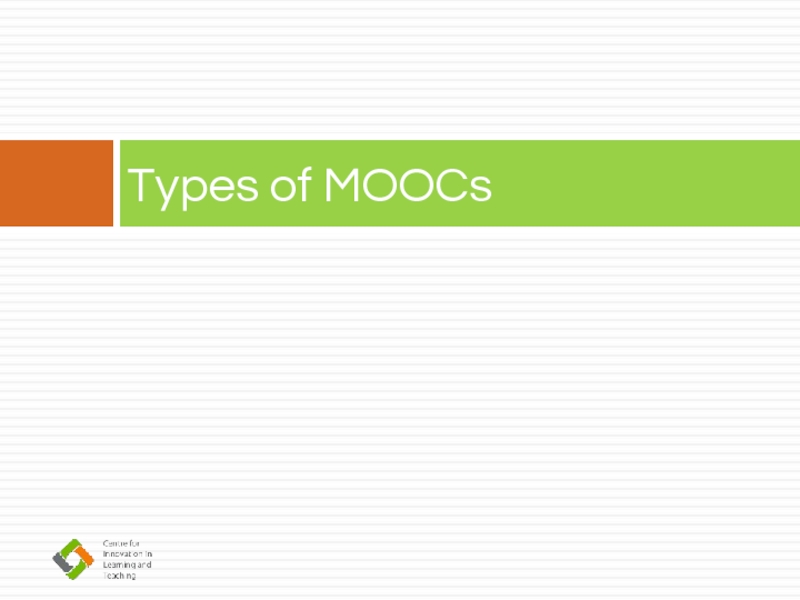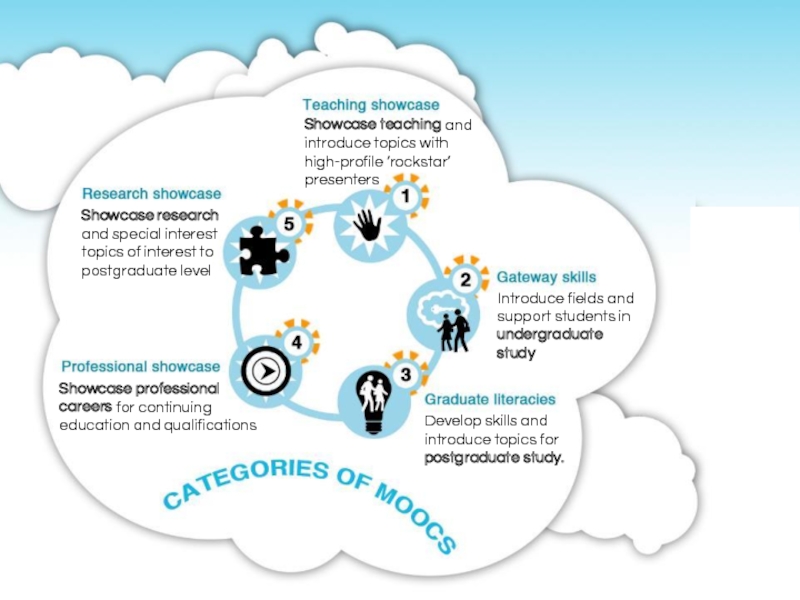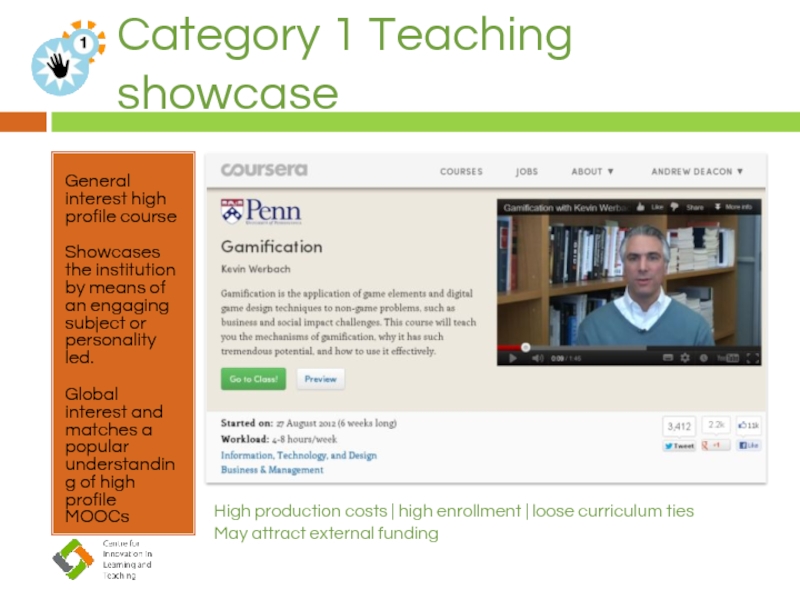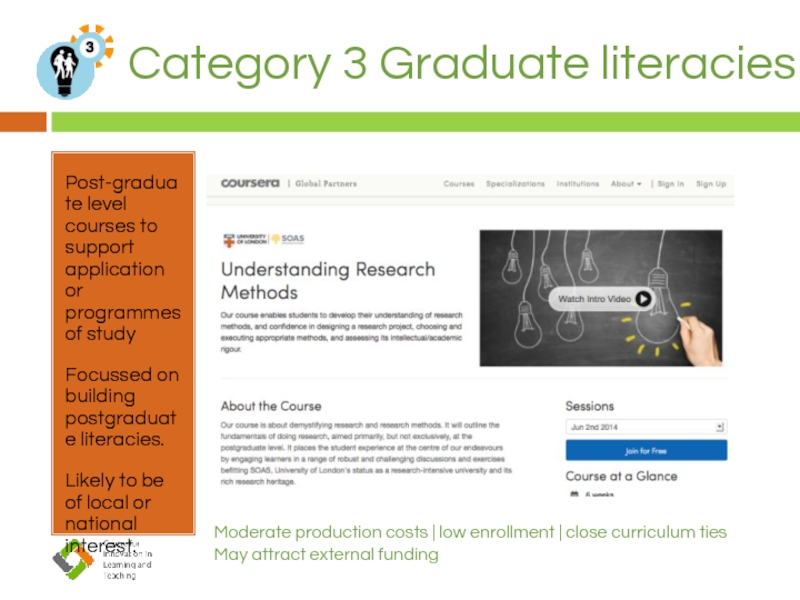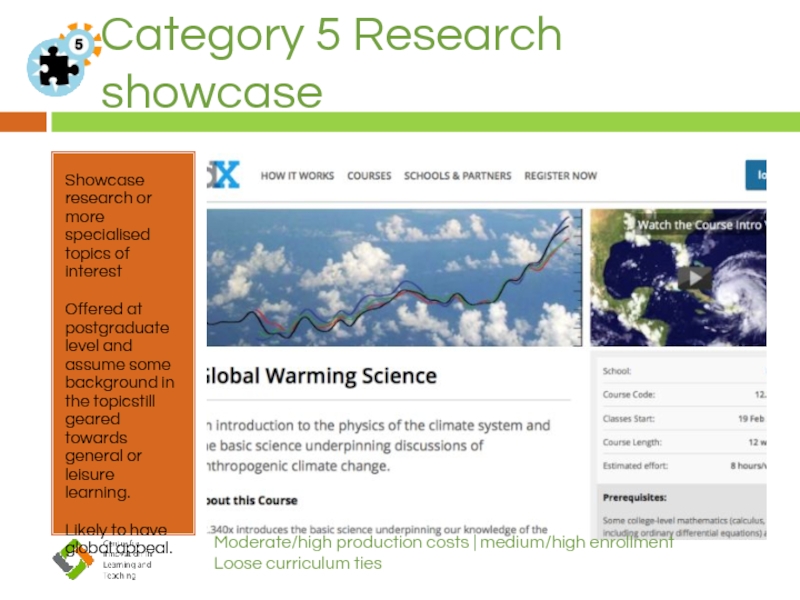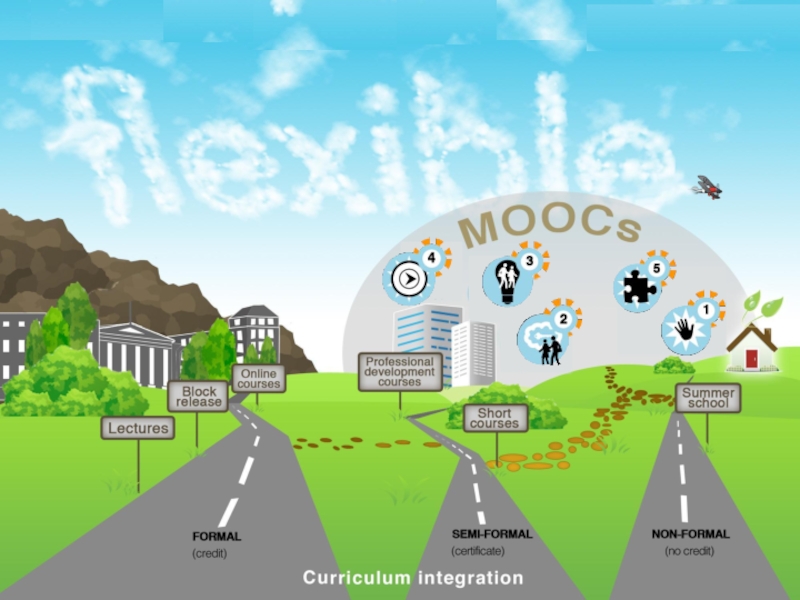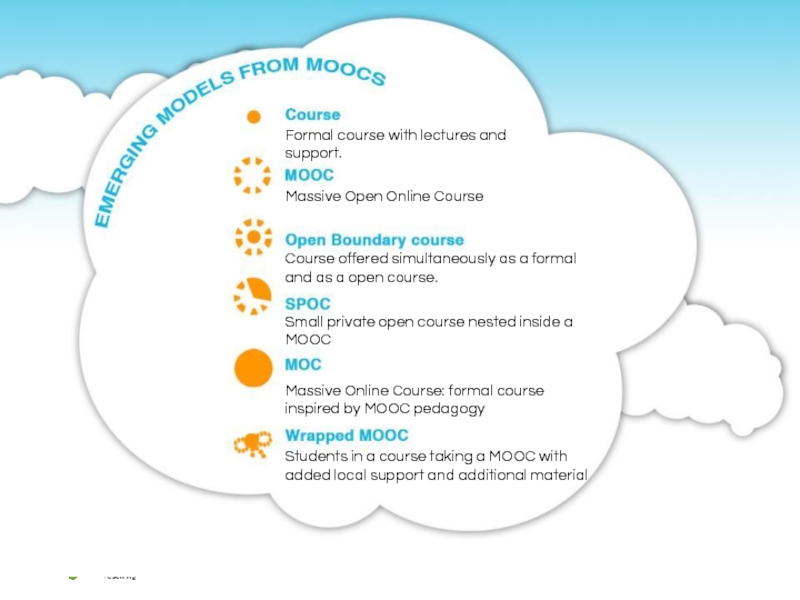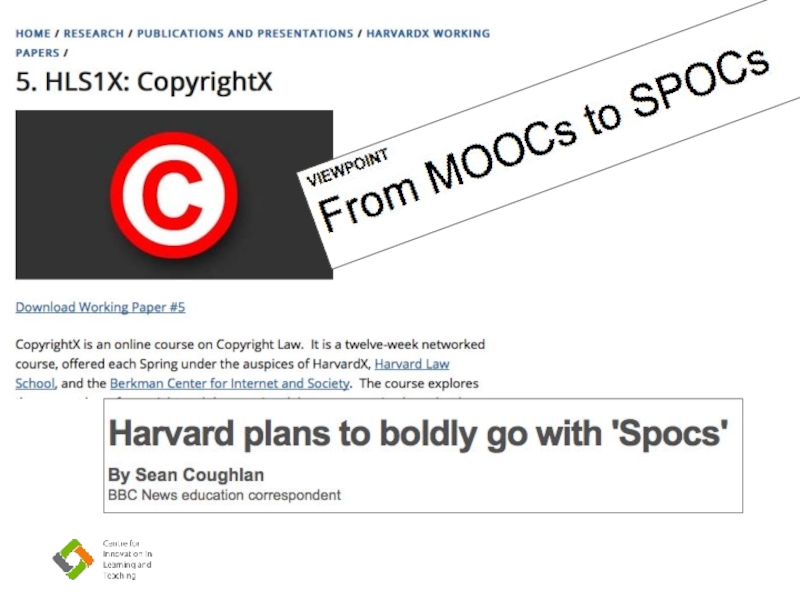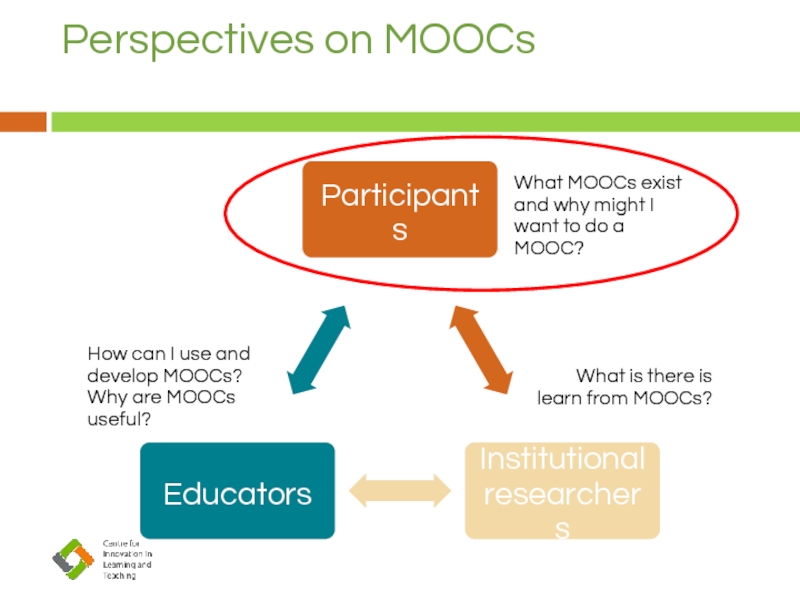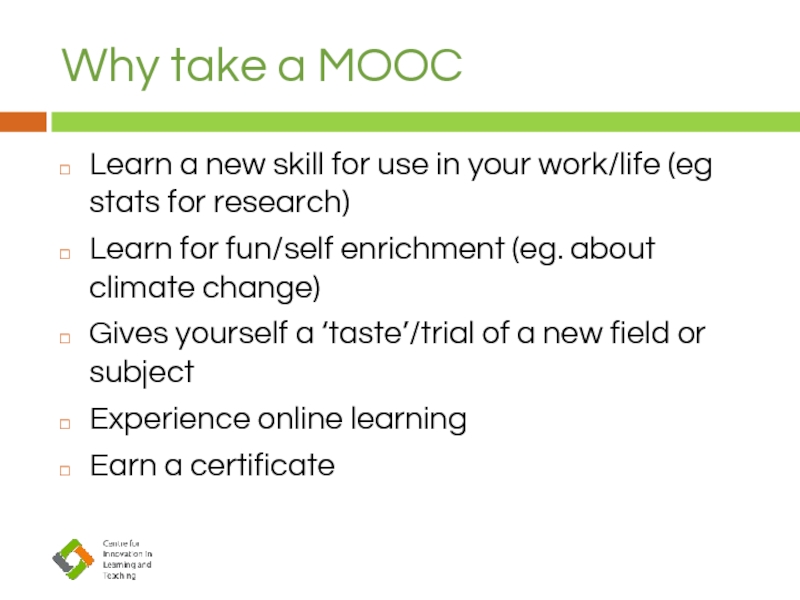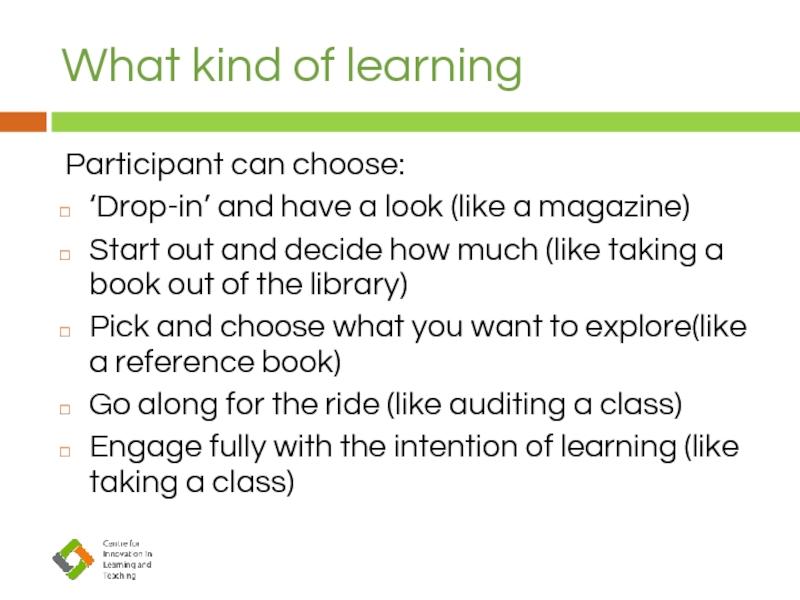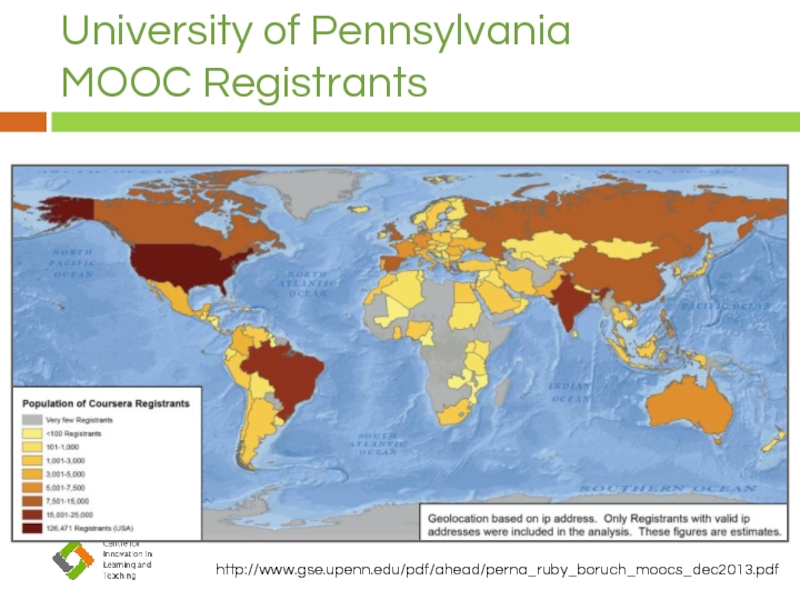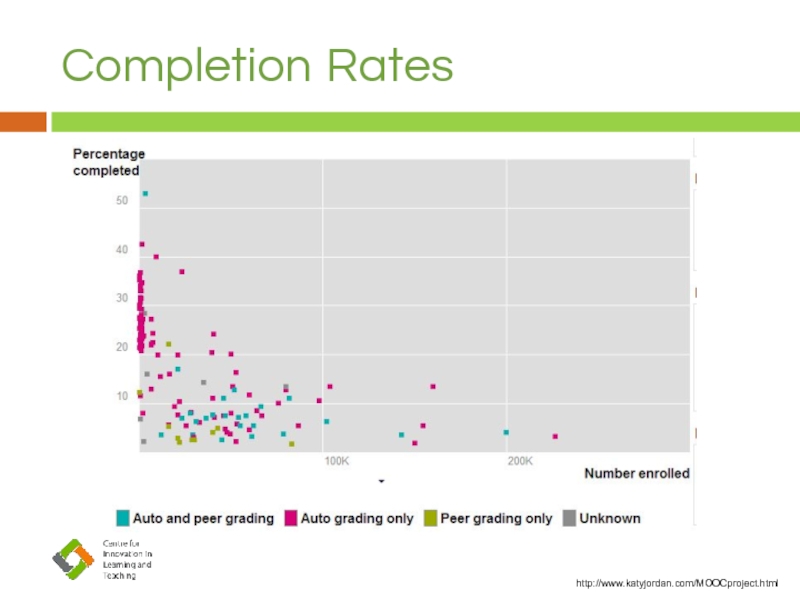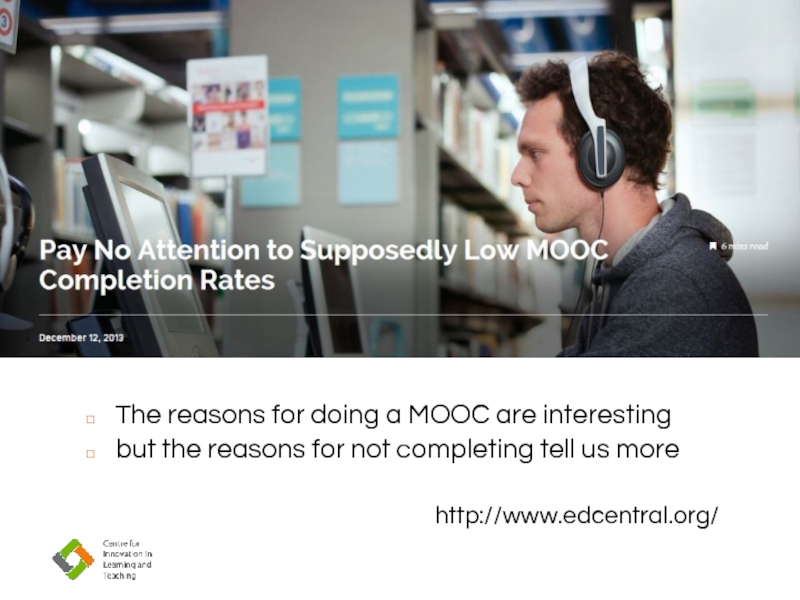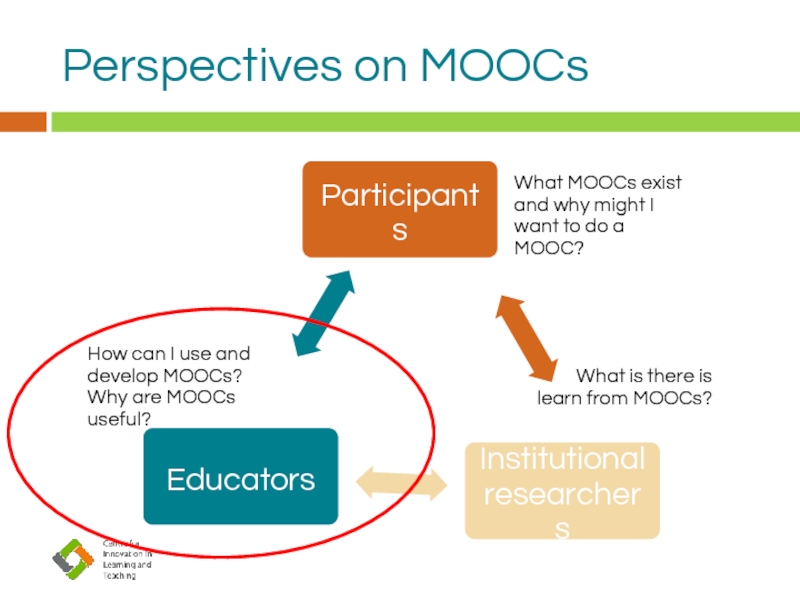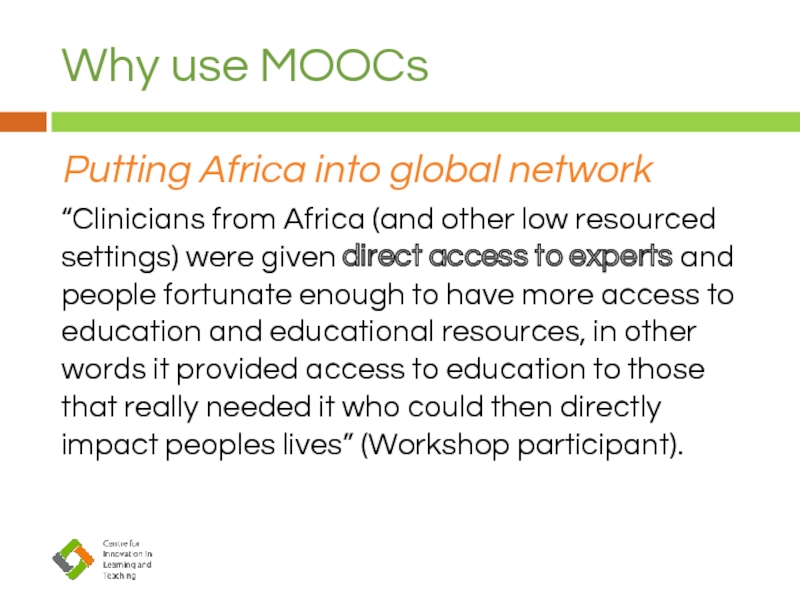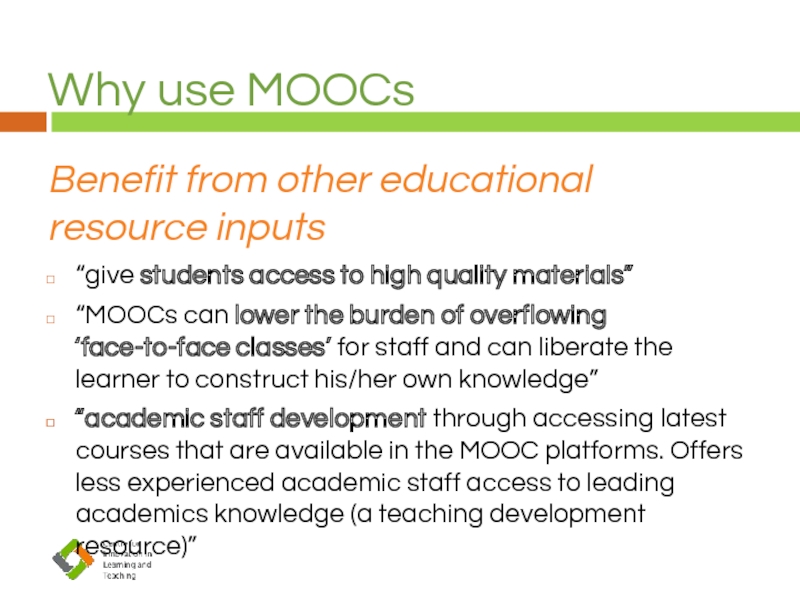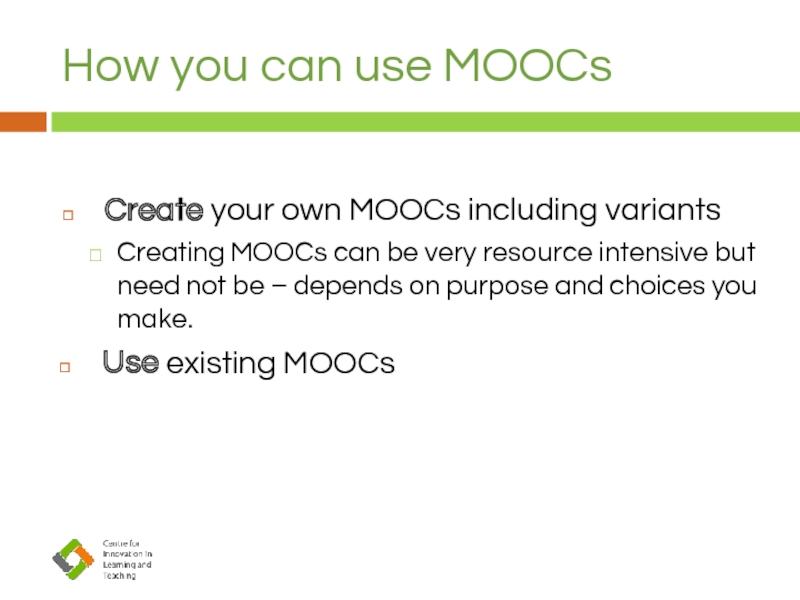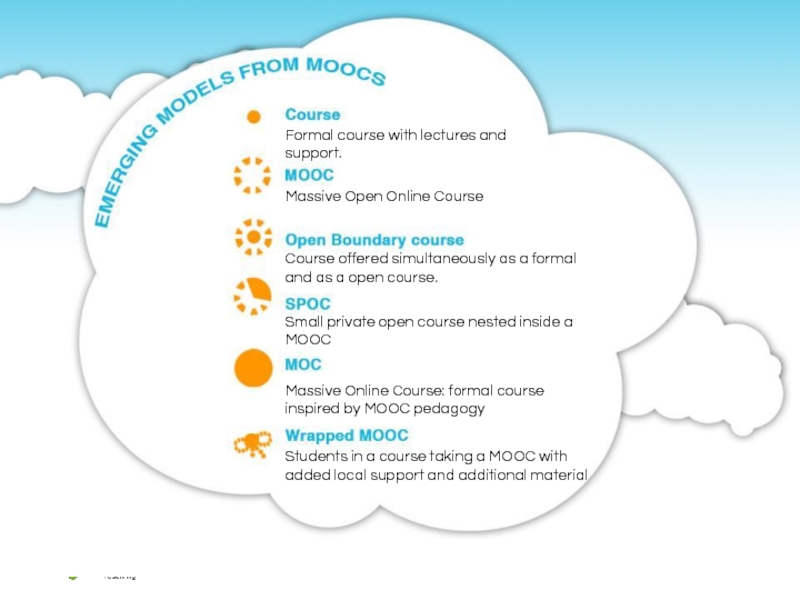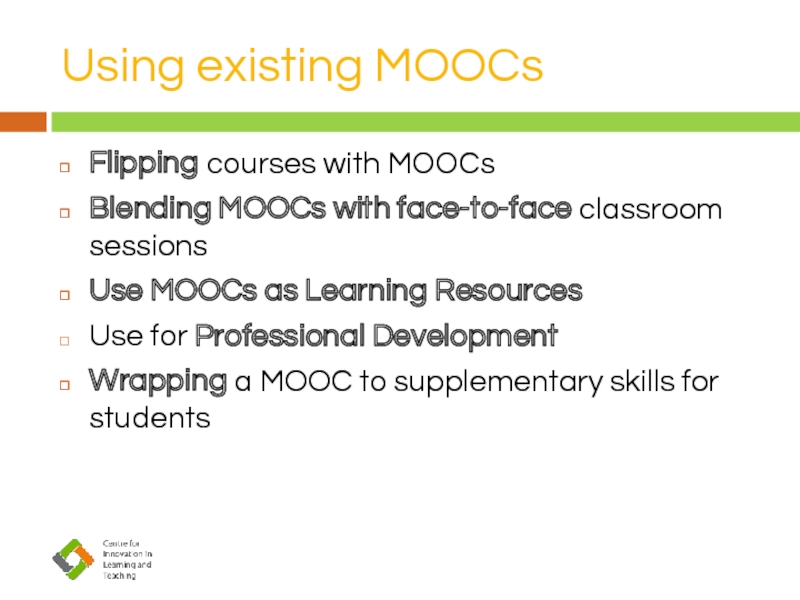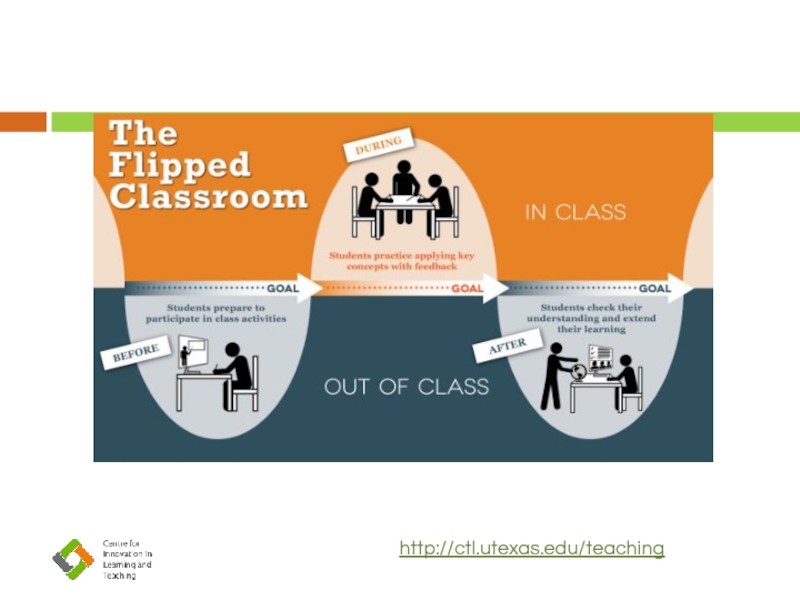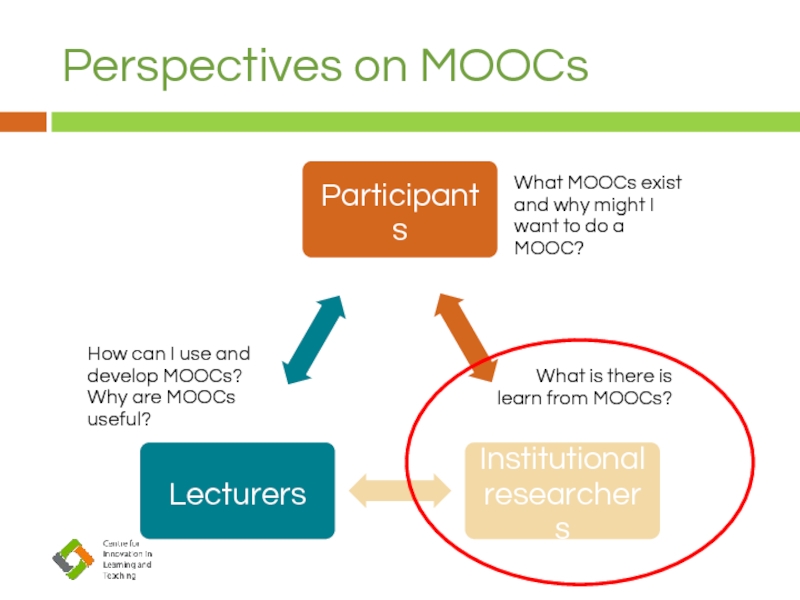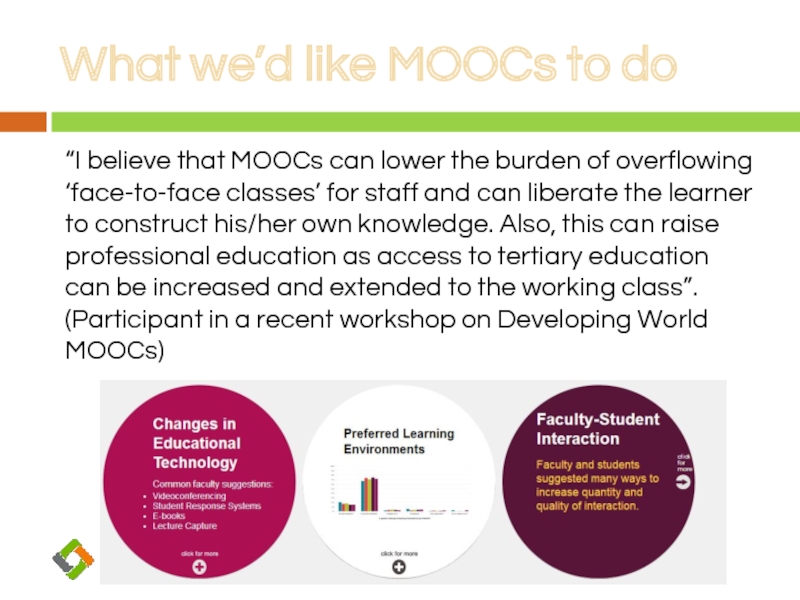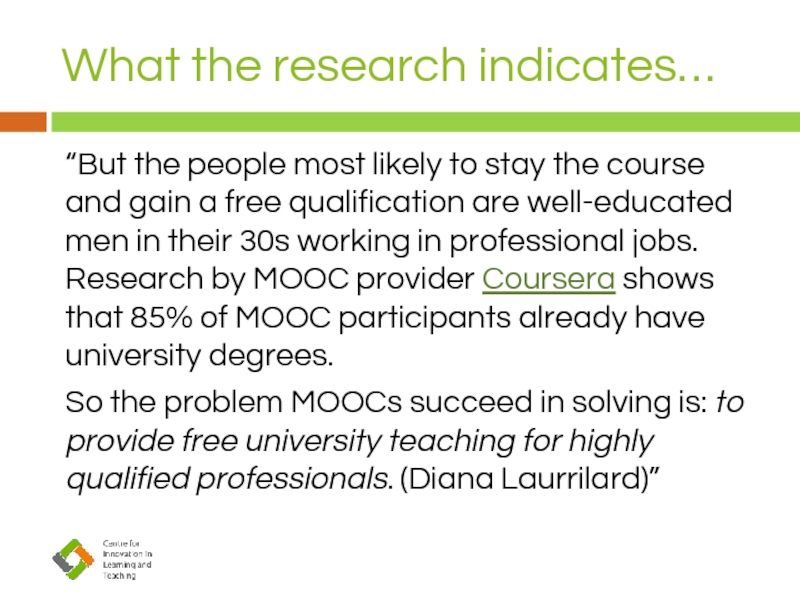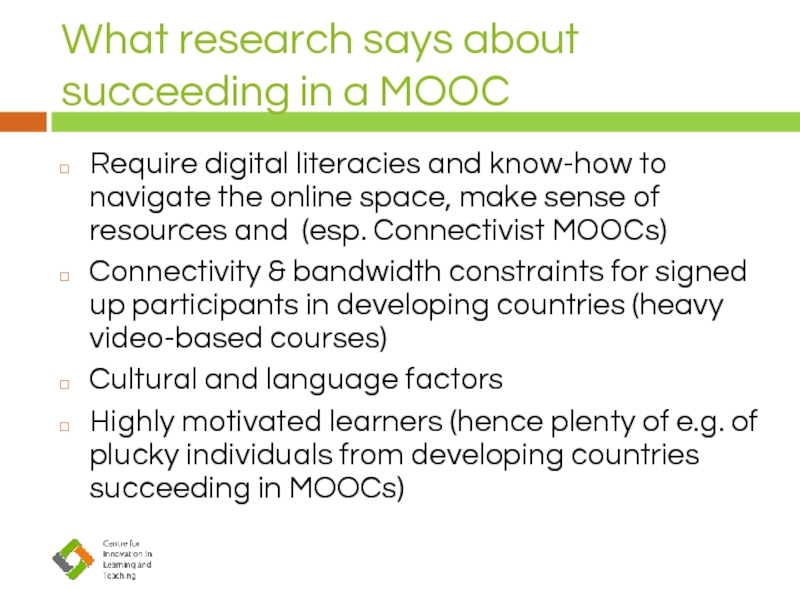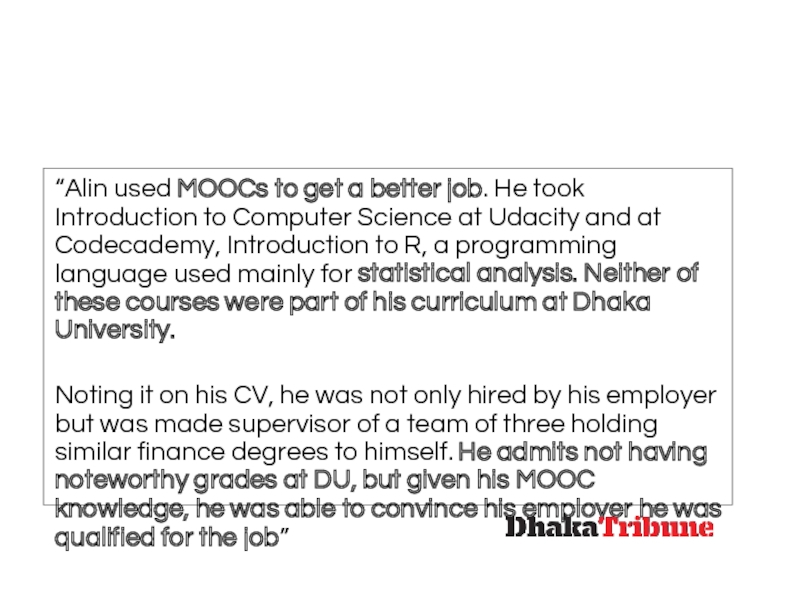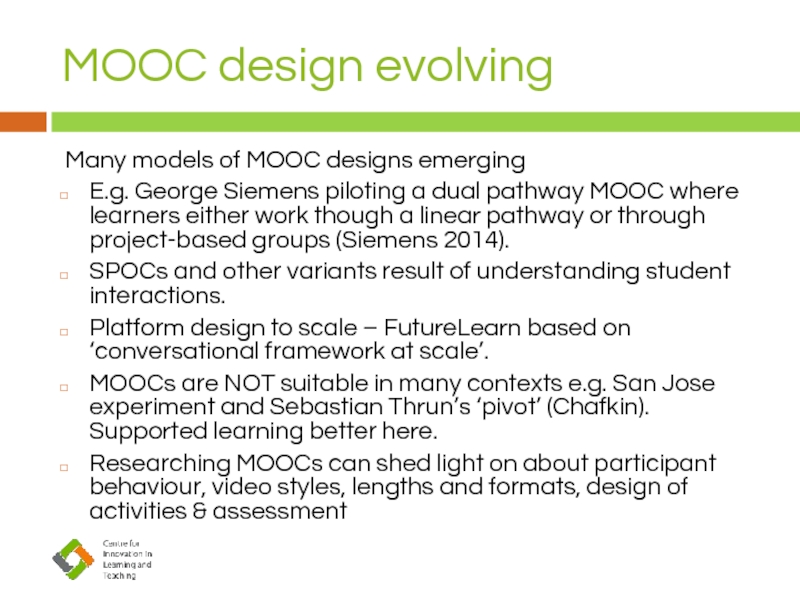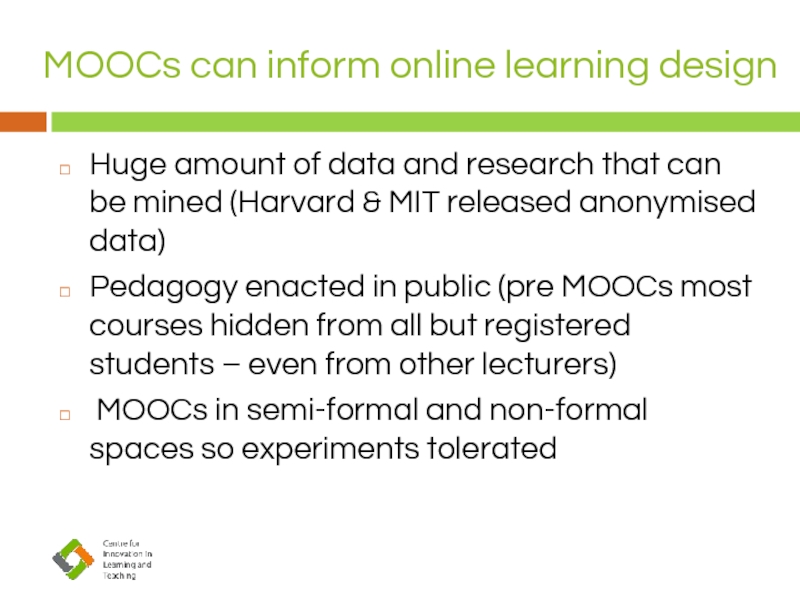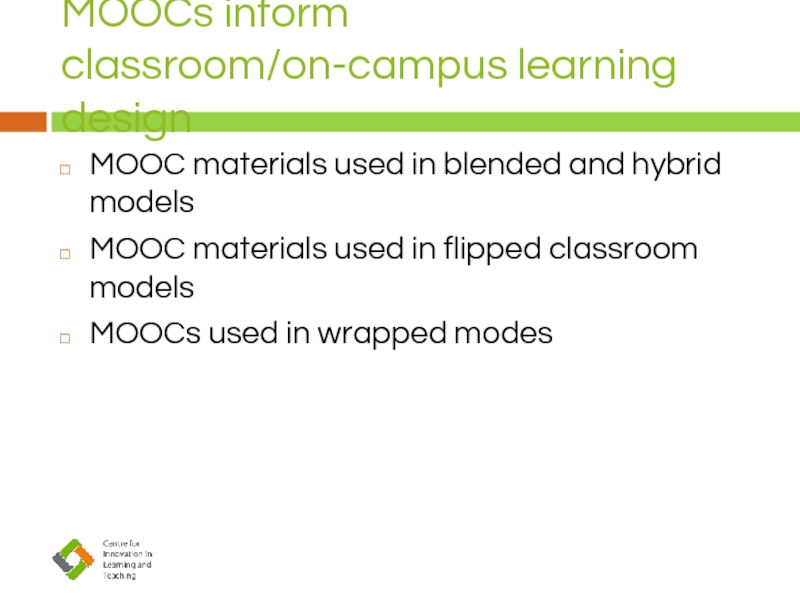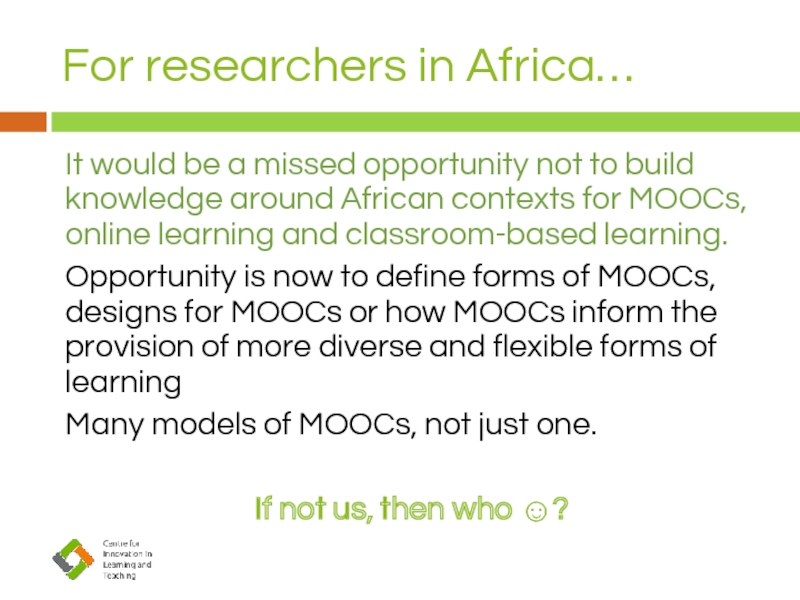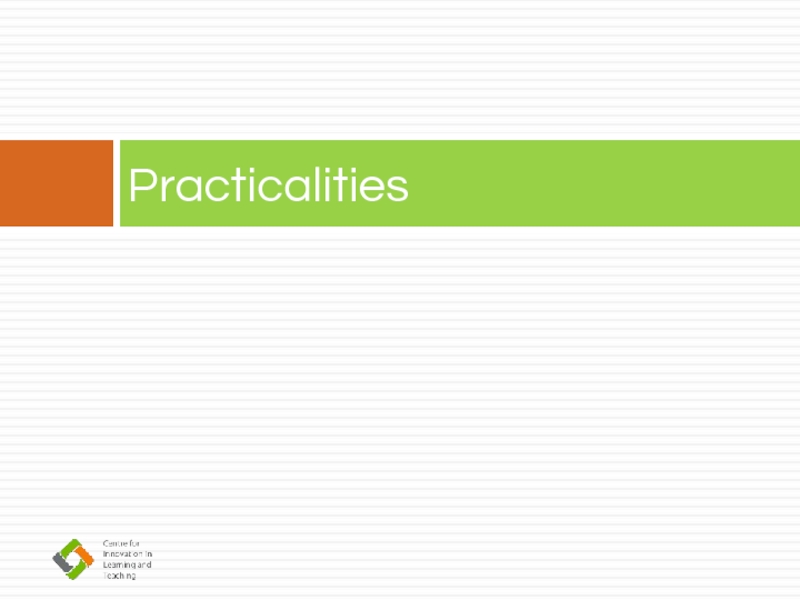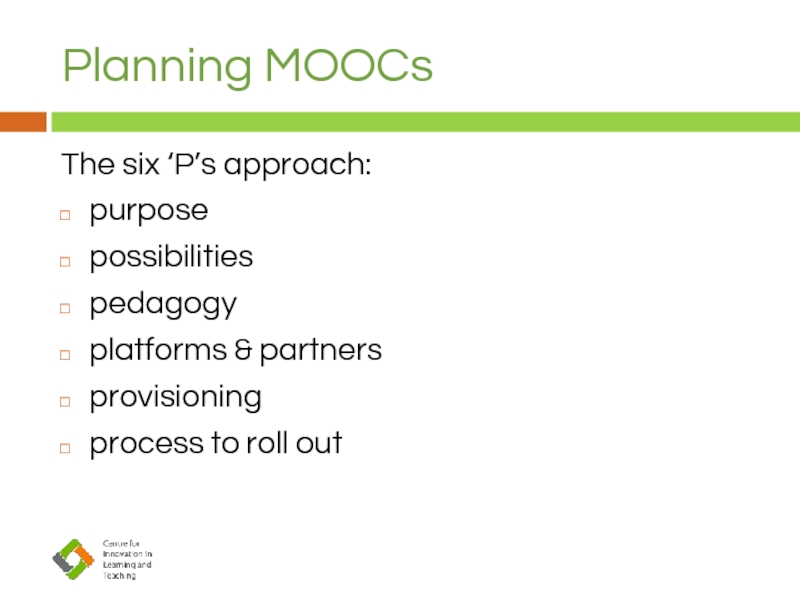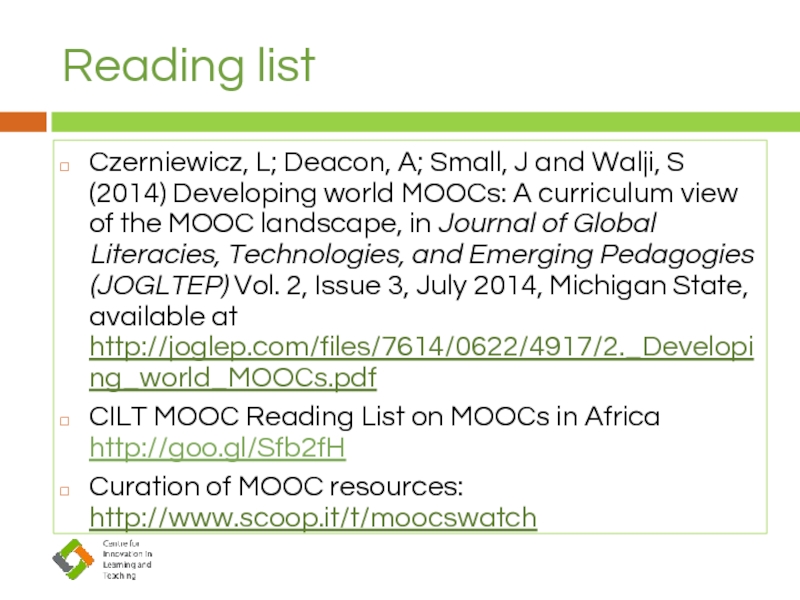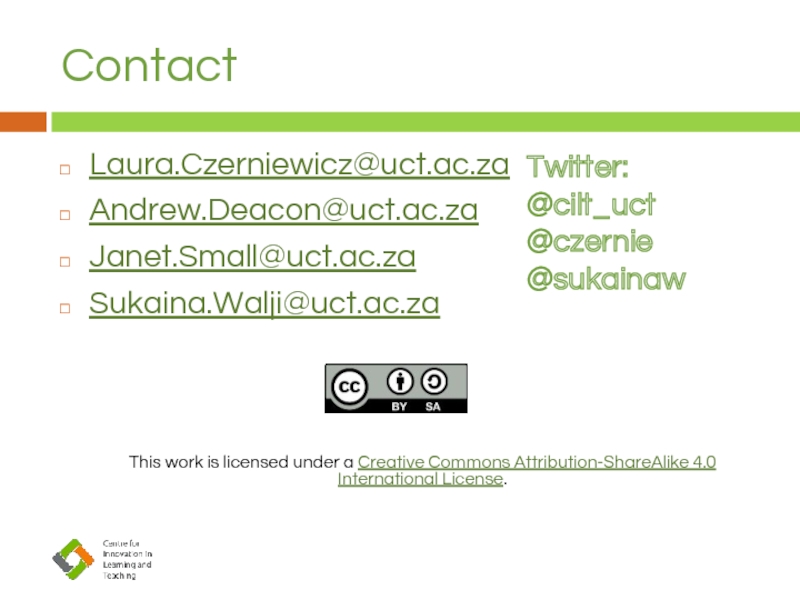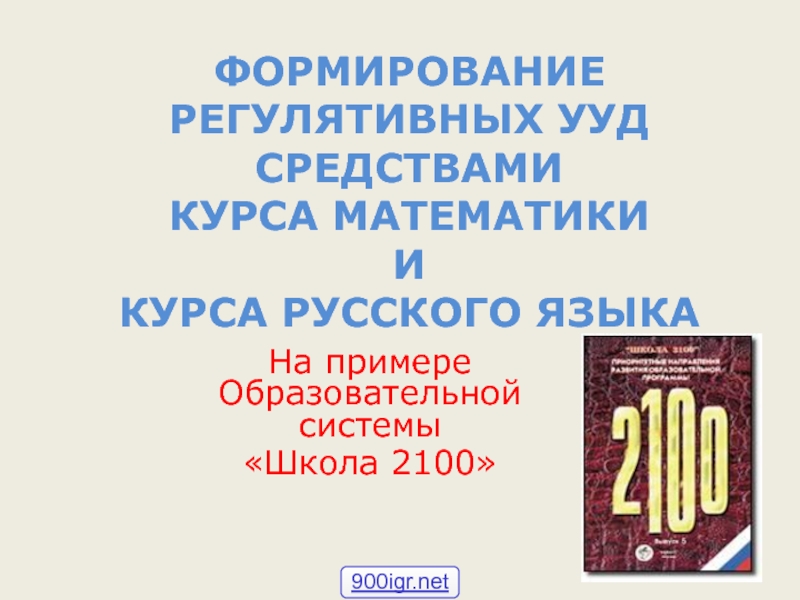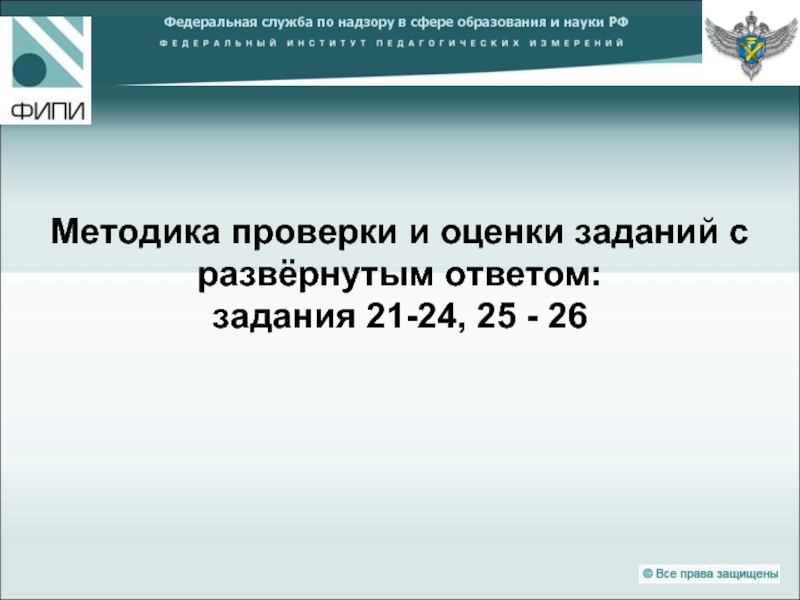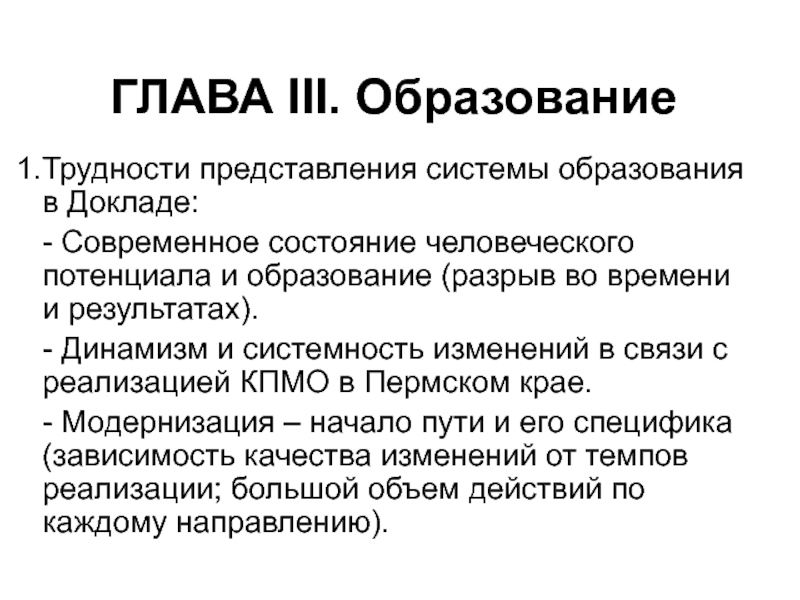- Главная
- Разное
- Дизайн
- Бизнес и предпринимательство
- Аналитика
- Образование
- Развлечения
- Красота и здоровье
- Финансы
- Государство
- Путешествия
- Спорт
- Недвижимость
- Армия
- Графика
- Культурология
- Еда и кулинария
- Лингвистика
- Английский язык
- Астрономия
- Алгебра
- Биология
- География
- Детские презентации
- Информатика
- История
- Литература
- Маркетинг
- Математика
- Медицина
- Менеджмент
- Музыка
- МХК
- Немецкий язык
- ОБЖ
- Обществознание
- Окружающий мир
- Педагогика
- Русский язык
- Технология
- Физика
- Философия
- Химия
- Шаблоны, картинки для презентаций
- Экология
- Экономика
- Юриспруденция
The Mysteryof MOOCsLaura Czerniewicz & Sukaina Walji презентация
Содержание
- 1. The Mysteryof MOOCsLaura Czerniewicz & Sukaina Walji
- 2. Introduction: the context of MOOCs
- 3. Teaching & learning interaction Assessment & certification Content Traditionally: a single package Time Space
- 4. Disaggregation Content Teaching & learning interaction Certification Time Platform
- 5. Disaggregation Content Teaching & learning interaction Assessment & certification Time Platform
- 6. Access to content Legal Digital Analogue Illegal
- 7. Disaggregation Content Teaching & learning interaction Certification Time Place
- 8. Disaggregation Content Teaching & learning interaction Certification Time Platform
- 9. Learning platforms Hill, P (6 Feb 2014) http://mfeldstein.com/resilient-higher-ed-lms-canvas/
- 10. Free content Pay to access platform
- 11. Changes in teaching & learning Content Teaching & learning interaction Certification Time Place
- 12. On campus Remote Internet supported Fully online
- 13. Disaggregation Content Teaching & learning interaction Certification Time Platform
- 14. Certification: non university providers
- 15. Certification: new forms Badges- micro, granular certification
- 16. Certification: new forms & providers “Degreed is
- 17. Certification: new forms
- 18. Certification: new forms
- 19. Certification: new forms £ 119 Pearson Vue Test Centre £ 24
- 20. Changing monetisation models
- 21. MOOCs
- 22. On campus Remote Internet supported Fully online
- 24. MOOCs did not just appear Open education Distance education Online education Long history 2012
- 25. April 2012 http://edutechnica.com/moocmap
- 26. October 2012 http://edutechnica.com/moocmap
- 27. April 2013 http://edutechnica.com/moocmap
- 28. October 2013 http://edutechnica.com/moocmap
- 29. Participants
- 30. Mapping the course landscape
- 32. Types of MOOCs
- 33. Showcase teaching and introduce topics with high-profile
- 34. Category 1 Teaching showcase General interest high
- 35. Category 1 Teaching showcase General interest high
- 36. Category 2 Gateway skills Provides foundational,
- 37. Category 3 Graduate literacies Post-graduate level
- 38. Category 4 Professional showcase Geared towards vocational
- 39. Category 5 Research showcase Showcase research or
- 40. Category 5 Research showcase Showcase research or
- 42. Course offered simultaneously as a formal and
- 45. Perspectives on MOOCs What MOOCs exist
- 46. Why take a MOOC Learn a new
- 47. What kind of learning Participant can choose:
- 49. University of Pennsylvania MOOC Registrants http://www.gse.upenn.edu/pdf/ahead/perna_ruby_boruch_moocs_dec2013.pdf
- 50. Completion Rates http://www.katyjordan.com/MOOCproject.html
- 51. The reasons for doing a MOOC are
- 52. Perspectives on MOOCs What MOOCs exist and
- 53. Why use MOOCs? extending the classroom
- 54. Why use MOOCs Putting Africa into global
- 55. Why use MOOCs Benefit from other
- 56. How you can use MOOCs Create
- 57. Course offered simultaneously as a formal and
- 58. Creating variants An example: ‘open boundary course’
- 59. Using existing MOOCs Flipping courses with MOOCs
- 60. http://ctl.utexas.edu/teaching
- 61. Perspectives on MOOCs What MOOCs exist and
- 62. A research opportunity The massiveness of MOOCs,
- 63. What we’d like MOOCs to do “I
- 64. What the research indicates… “But the people
- 65. What research says about succeeding in a
- 66. “Alin used MOOCs to get a
- 67. MOOC design evolving Many models of MOOC
- 68. MOOCs can inform online learning design Huge
- 69. MOOCs inform classroom/on-campus learning design MOOC materials
- 70. For researchers in Africa… It would be
- 71. Practicalities
- 72. Planning MOOCs The six ‘P’s approach: purpose
- 73. Reading list Czerniewicz, L; Deacon, A; Small,
- 74. Contact Laura.Czerniewicz@uct.ac.za Andrew.Deacon@uct.ac.za Janet.Small@uct.ac.za Sukaina.Walji@uct.ac.za
Слайд 3
Teaching & learning interaction
Assessment & certification
Content
Traditionally: a single package
Time
Space
Слайд 6Access to content
Legal
Digital
Analogue
Illegal
Textbooks
Some photocopying
E-Textbooks
Open Education Resources
Photocopying
Pirate sites
File sharing
Слайд 12On campus
Remote
Internet supported
Fully online
F2F only
Forms of provision
Location
of students
Internet dependent
Online-intensive
Слайд 15Certification: new forms
Badges- micro, granular certification
A form of formal(ised) recognition
for informal
for chunks of content
for competencies
Слайд 16Certification: new forms & providers
“Degreed is a community of college students,
Degreed - launched in 2013
Слайд 22On campus
Remote
Internet supported
Fully online
F2F only
Forms of provision
Location
of students
Internet dependent
Online-intensive
MOOCs
Слайд 33Showcase teaching and introduce topics with high-profile ‘rockstar’ presenters
Introduce fields and
Develop skills and introduce topics for postgraduate study.
Showcase research and special interest topics of interest to postgraduate level
Showcase professional careers for continuing education and qualifications
Слайд 34Category 1 Teaching showcase
General interest high profile course
Showcases the institution
Global interest and matches a popular understanding of high profile MOOCs
n
High production costs | high enrollment | loose curriculum ties
May attract external funding
Слайд 35Category 1 Teaching showcase
General interest high profile course
Showcases the institution
Global interest and matches a popular understanding of high profile MOOCs
n
High production costs | high enrollment | loose curriculum ties
May attract external funding
Слайд 36Category 2 Gateway skills
Provides foundational, bridging or enhancement skills for
Could replace teaching for 'bottleneck courses.’
Local interest, either within the institution or at a country-wide setting.
Moderate production costs | low enrollment | close curriculum ties
May attract external funding |
Слайд 37Category 3 Graduate literacies
Post-graduate level courses to support application or
Focussed on building postgraduate literacies.
Likely to be of local or national interest.
Moderate production costs | low enrollment | close curriculum ties
May attract external funding
Слайд 38Category 4 Professional showcase
Geared towards vocational skills development, re-tooling and professional
Could be offered in conjunction with professional bodies.
Likely to be of local interest, although some specialised topics may be globally relevant. .
Moderate to high production costs |medium to high enrollment
Close curriculum ties |May attract organisational funding
High potential for pathway to credit or revenue generation
Слайд 39Category 5 Research showcase
Showcase research or more specialised topics of interest
Offered at postgraduate level and assume some background in the topicstill geared towards general or leisure learning.
Likely to have global appeal.
Moderate/high production costs | medium/high enrollment
Loose curriculum ties
Слайд 40Category 5 Research showcase
Showcase research or more specialised topics of interest
Offered at postgraduate level and assume some background in the topicstill geared towards general or leisure learning.
Likely to have global appeal.
Moderate/high production costs | medium/high enrollment
Loose curriculum ties
Слайд 42Course offered simultaneously as a formal and as a open course.
Small
Massive Online Course: formal course inspired by MOOC pedagogy
Students in a course taking a MOOC with added local support and additional material
Massive Open Online Course
Formal course with lectures and support.
Слайд 45Perspectives on MOOCs
What MOOCs exist and why might I want to
What is there is learn from MOOCs?
How can I use and develop MOOCs? Why are MOOCs useful?
Слайд 46Why take a MOOC
Learn a new skill for use in your
Learn for fun/self enrichment (eg. about climate change)
Gives yourself a ‘taste’/trial of a new field or subject
Experience online learning
Earn a certificate
Слайд 47What kind of learning
Participant can choose:
‘Drop-in’ and have a look (like
Start out and decide how much (like taking a book out of the library)
Pick and choose what you want to explore(like a reference book)
Go along for the ride (like auditing a class)
Engage fully with the intention of learning (like taking a class)
Слайд 49University of Pennsylvania MOOC Registrants
http://www.gse.upenn.edu/pdf/ahead/perna_ruby_boruch_moocs_dec2013.pdf
Слайд 51The reasons for doing a MOOC are interesting
but the reasons for
http://www.edcentral.org/
Слайд 52Perspectives on MOOCs
What MOOCs exist and why might I want to
What is there is learn from MOOCs?
How can I use and develop MOOCs? Why are MOOCs useful?
Слайд 53Why use MOOCs?
extending the classroom
building networks
exposure to different contexts
accessing experts
bringing in
putting African participants into a global network
benefit from other (high quality) educational resource inputs
supplement gaps in current provision
Слайд 54Why use MOOCs
Putting Africa into global network
“Clinicians from Africa (and
Слайд 55Why use MOOCs
Benefit from other educational resource inputs
“give students access to
“MOOCs can lower the burden of overflowing ‘face-to-face classes’ for staff and can liberate the learner to construct his/her own knowledge”
“academic staff development through accessing latest courses that are available in the MOOC platforms. Offers less experienced academic staff access to leading academics knowledge (a teaching development resource)”
Слайд 56How you can use MOOCs
Create your own MOOCs including variants
Creating MOOCs
Use existing MOOCs
Слайд 57Course offered simultaneously as a formal and as a open course.
Small
Massive Online Course: formal course inspired by MOOC pedagogy
Students in a course taking a MOOC with added local support and additional material
Massive Open Online Course
Formal course with lectures and support.
Слайд 58Creating variants
An example: ‘open boundary course’ can be a lower cost
Key benefit: Bringing a more diverse student body into existing course – open boundary courses
Distance education in developing world & Africa has been offering massive enrollments but only now tentatively venturing into online and blended forms e.g. Unisa offering MOCs
Слайд 59Using existing MOOCs
Flipping courses with MOOCs
Blending MOOCs with face-to-face classroom
Use MOOCs as Learning Resources
Use for Professional Development
Wrapping a MOOC to supplementary skills for students
Слайд 61Perspectives on MOOCs
What MOOCs exist and why might I want to
What is there is learn from MOOCs?
How can I use and develop MOOCs? Why are MOOCs useful?
Слайд 62A research opportunity
The massiveness of MOOCs, their accessibility, and the wide
Слайд 63What we’d like MOOCs to do
“I believe that MOOCs can lower
Слайд 64What the research indicates…
“But the people most likely to stay the
So the problem MOOCs succeed in solving is: to provide free university teaching for highly qualified professionals. (Diana Laurrilard)”
Слайд 65What research says about succeeding in a MOOC
Require digital literacies and
Connectivity & bandwidth constraints for signed up participants in developing countries (heavy video-based courses)
Cultural and language factors
Highly motivated learners (hence plenty of e.g. of plucky individuals from developing countries succeeding in MOOCs)
Слайд 66
“Alin used MOOCs to get a better job. He took Introduction
Noting it on his CV, he was not only hired by his employer but was made supervisor of a team of three holding similar finance degrees to himself. He admits not having noteworthy grades at DU, but given his MOOC knowledge, he was able to convince his employer he was qualified for the job”
Слайд 67MOOC design evolving
Many models of MOOC designs emerging
E.g. George Siemens piloting
SPOCs and other variants result of understanding student interactions.
Platform design to scale – FutureLearn based on ‘conversational framework at scale’.
MOOCs are NOT suitable in many contexts e.g. San Jose experiment and Sebastian Thrun’s ‘pivot’ (Chafkin). Supported learning better here.
Researching MOOCs can shed light on about participant behaviour, video styles, lengths and formats, design of activities & assessment
Слайд 68MOOCs can inform online learning design
Huge amount of data and research
Pedagogy enacted in public (pre MOOCs most courses hidden from all but registered students – even from other lecturers)
MOOCs in semi-formal and non-formal spaces so experiments tolerated
Слайд 69MOOCs inform classroom/on-campus learning design
MOOC materials used in blended and hybrid
MOOC materials used in flipped classroom models
MOOCs used in wrapped modes
Слайд 70For researchers in Africa…
It would be a missed opportunity not to
Opportunity is now to define forms of MOOCs, designs for MOOCs or how MOOCs inform the provision of more diverse and flexible forms of learning
Many models of MOOCs, not just one.
If not us, then who ☺?
Слайд 72Planning MOOCs
The six ‘P’s approach:
purpose
possibilities
pedagogy
platforms & partners
provisioning
process to roll out
Слайд 73Reading list
Czerniewicz, L; Deacon, A; Small, J and Walji, S (2014)
CILT MOOC Reading List on MOOCs in Africa http://goo.gl/Sfb2fH
Curation of MOOC resources: http://www.scoop.it/t/moocswatch
Слайд 74Contact
Laura.Czerniewicz@uct.ac.za
Andrew.Deacon@uct.ac.za
Janet.Small@uct.ac.za
Sukaina.Walji@uct.ac.za
This work is licensed under a Creative Commons Attribution-ShareAlike 4.0 International
Twitter:
@cilt_uct
@czernie
@sukainaw
